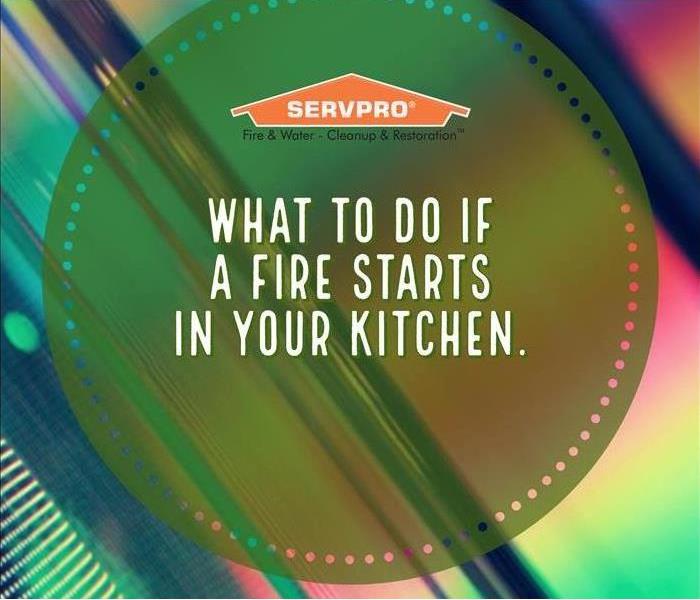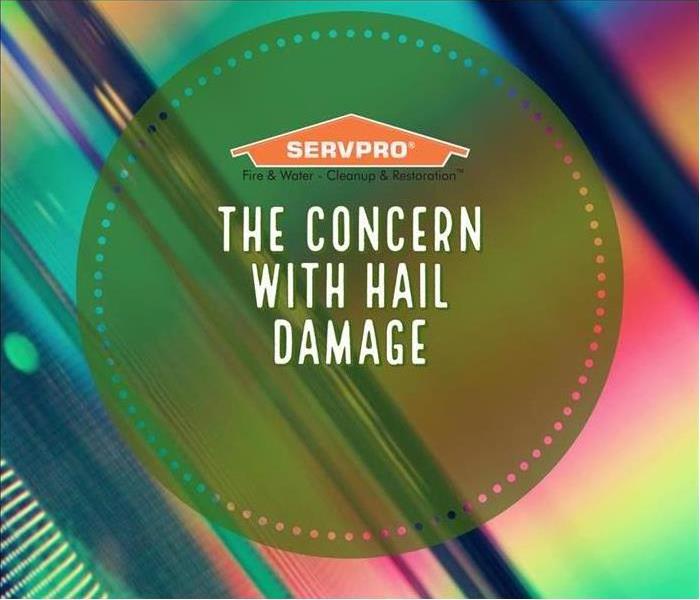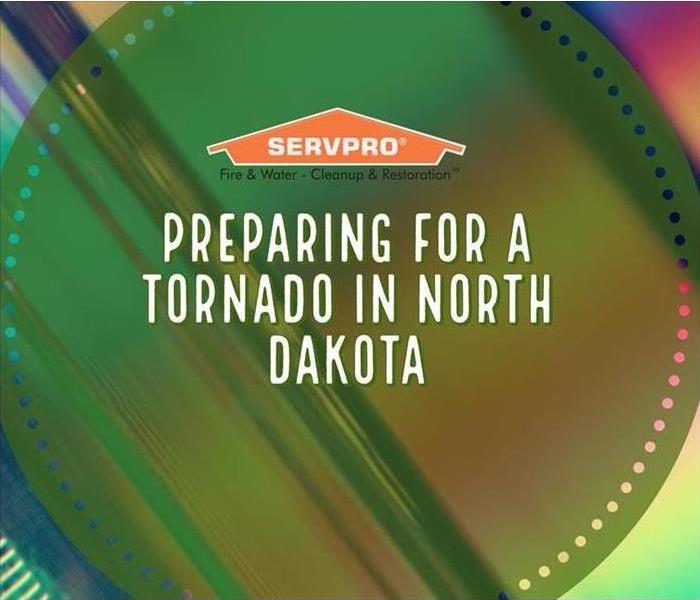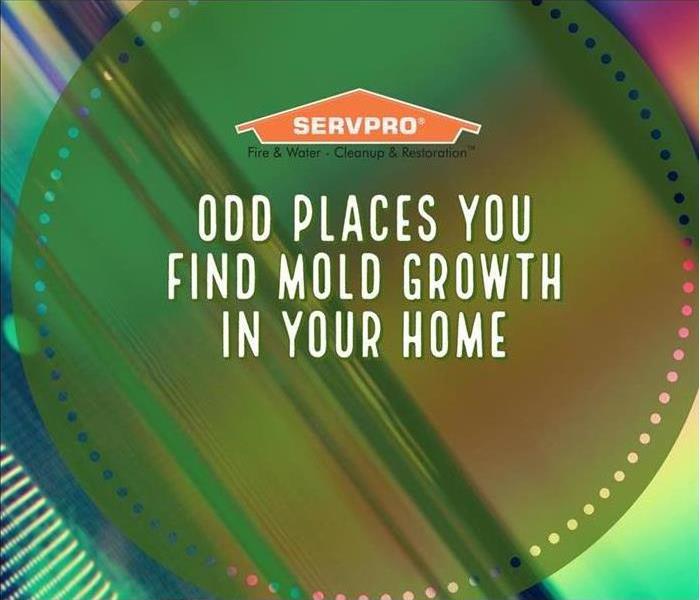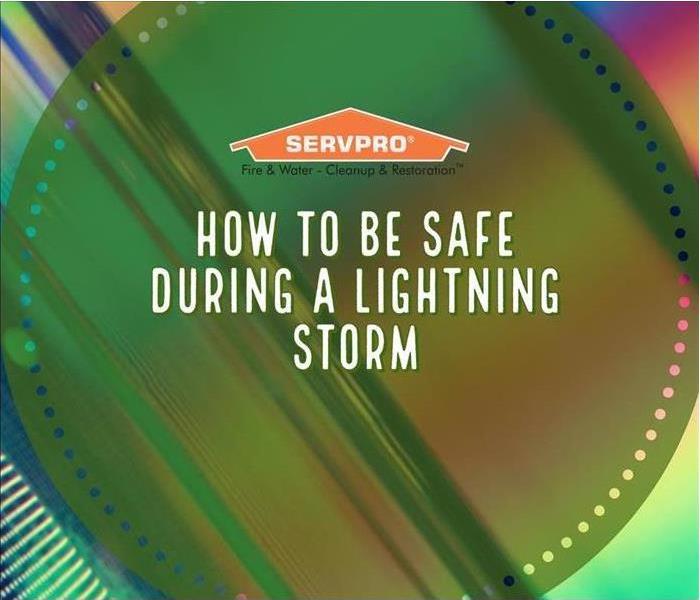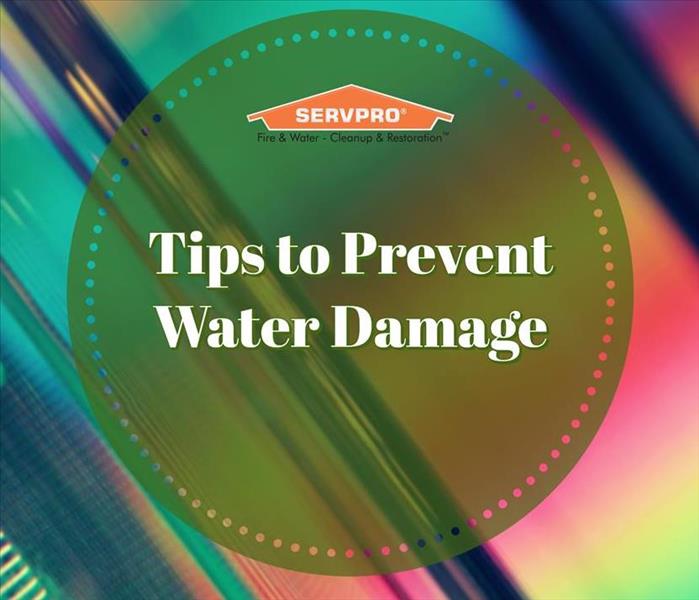Archived Blog Posts
Safety with Space Heaters
8/29/2022 (Permalink)
 Be safe with space heaters!
Be safe with space heaters!
With winter in full swing, many of us have broken out space heaters to keep ourselves warm. Whether it is at work or at home, space heaters are a great way to stay toasty when the temperatures get to be in the negatives for days on end.
When using a space heater, however, it is important to follow best safety practices to prevent a fire. Space heaters are perfectly safe when used properly. Use the tips below and keep your home and office safe and warm this winter.
- Leave the heater on level floor. Don't place on carpet - it can overheat and start a fire.
- Do not use in bathroom, unless it is designed for it - moisture can damage the heater.
- Keep three feet away from flammable materials and out of the way of children and pets.
- Should always be plugged directly into wall outlet. Don't use with extension cord because it can cause overheating.
- Don't leave heater unattended. Make sure to unplug when not in use.
- Never sleep with a space heater on.
- Install smoke alarms on every floor.
If your space heater shows signs of wear such as broken cords, power fluctuations, or inconsistent temperature, immediately replace. An old space heaters can malfunction and start a fire or overheat and leave an odor/smoke smell in the air. Never overuse a space heater and if you smell burning, immediately unplug and discontinue use.
When dealing with frigid temperatures, space heaters are a quick solution to help fight the cold. Using them safely will keep you warm and your home or office safe this winter.
Does Windchill Affect Your Home?
8/29/2022 (Permalink)
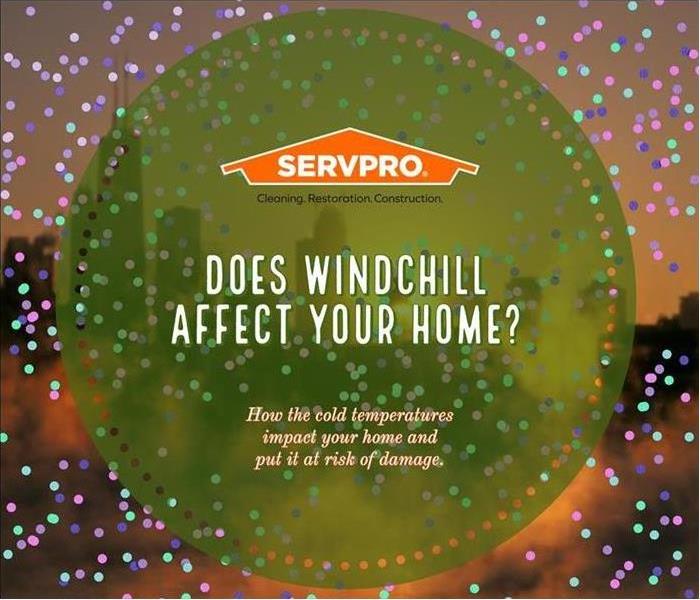 Keep toasty this winter!
Keep toasty this winter!
In North Dakota, we are used to the phrase "It wouldn't be so cold if wasn't for the wind." Windchill is calculated though a formula that describes how much colder the air temperature is due to heat loss caused by winds. While Windchill is usually used to describe how the temperature affects humans, it is important to remember how it can damage your home.
The same way humans give off heat through their skin, homes give off heat through low insulated spots such as windows, open doors, or leaks. The more insulated a home is, the better it will be at retaining heat. Windchill affects every and all objects, until it doesn't. It stops having an effect when the object is the same temperature as the actual air temperature. Any warm heat sources, like your body or your home that are trying to maintain a warm temperature in a cold environment, will be affected by wind chill.
When a wind chill advisory is in effect, if you have a drafty home or if you accidentally leave the fireplace flue open or a window is not fully closed, the cold wind is going to have a noticeable effect on your home heating and home comfort. Make sure to insulate and seal up your house as much as possible. A poorly insulated home is susceptible to water damage caused from leaks or frozen pipes.
When dealing with cold temperatures, wind can have an additional impact on your home and heating bill. Properly insulating your home and sealing up cracks or other drafts can make a huge difference in the lifespan and value of your home. When the wind chill temperature gets lower, be sure to keep your home protected and prevent disaster.
Dealing with Commercial Water Damage
8/29/2022 (Permalink)
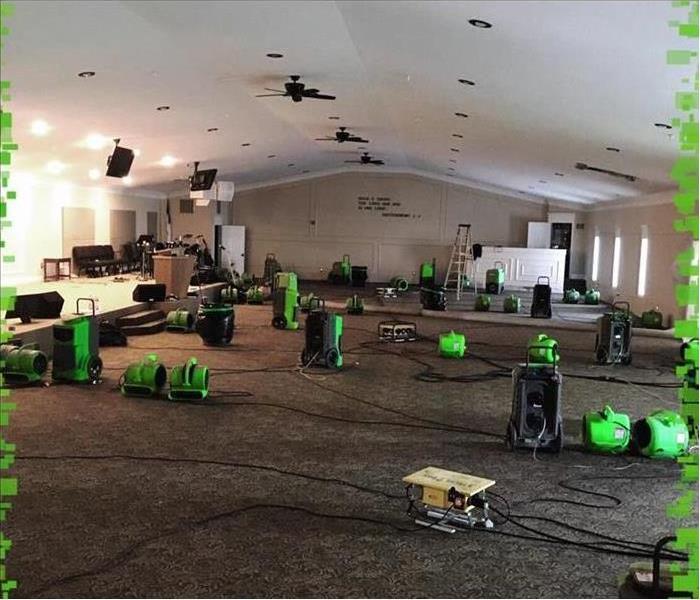 Water loss at at a commercial property
Water loss at at a commercial property
When dealing with water damage, bigger is almost always worse. The more water that is flowing through a space, the worse the damage will usually be. Water damage in commercial buildings has the potential to be far more disastrous than a residential home, because of how many more pipes there are in a commercial building. More bathrooms, appliances, and sprinkler systems mean there are a greater number of chances for water loss, whether this is from a frozen pipe or one that has not been maintained properly.
With commercial loss, it also means more equipment will need to be used to dry out the area. More equipment means more manpower needed to move the equipment. This trend can keep compounding out to show how commercial job can have costs add up quickly.
It is also the cost of not doing business that makes a large water loss so damaging. Not being able to have a store/location open for days, weeks, or months at a time can mean a devastating loss of profit which will just make a water loss worse. This is why SERVPRO of Bismarck uses every method to expedite the restoration process, such as working directly with insurance providers, offering construction services, and using state of the art equipment to get the restoration process completed fast!
Large commercial water losses can be scary. SERVPRO of Bismarck relies on our experience to get the damage under control and back to normal.
When Does Water Damage Cause Mold?
8/29/2022 (Permalink)
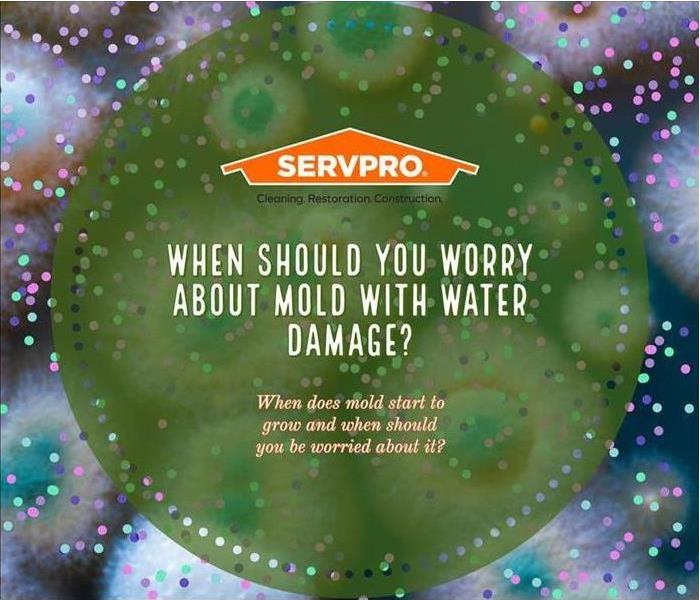 Mold growth is a nasty business!
Mold growth is a nasty business!
Whenever you have a water loss, it is a nerve-racking experience. You have to worry about cleaning up the water, drying out what's affected, and possible mold growth. Sometimes you can take care of these things on your own, other times a professional company, like SERVPRO®, needs to come in and assess and then clean it. With any water loss, mold should be a worry, but when does water actually cause mold growth?
Different types of water damage that can cause mold growth are:
- Sewage back-up from flooding in the area
- Plumbing or roof leaks
- Damp basement or crawl space
- Overflows from sinks for bathtub
- High humidity: steam cooking, dryer vents, humidifiers
- Any type of stagnant water in your home
Mold will begin to grow 24-48 hours after the initial water damage. If you discover the source of damage, stop it quickly, and clean up the mess, you likely don't have to worry about mold. If the water damage isn't found within a few days, mold is going to become a concern.
If the water is not dried out within that time window, a professional may apply antimicrobial products to prevent growth. This is why you should contact a professional no later than 48 hours after the initial damage if there is still moisture present.
The best way to prevent mold growth from water damage is to clean up the water and dry out the area as fast as possible. If you aren't sure whether or not you can dry it out on your own, contact SERVPRO of Bismarck and we can advise you on the next steps to take to prevent further damage to your home.
Dealing with Large Commercial Water Damage
8/29/2022 (Permalink)
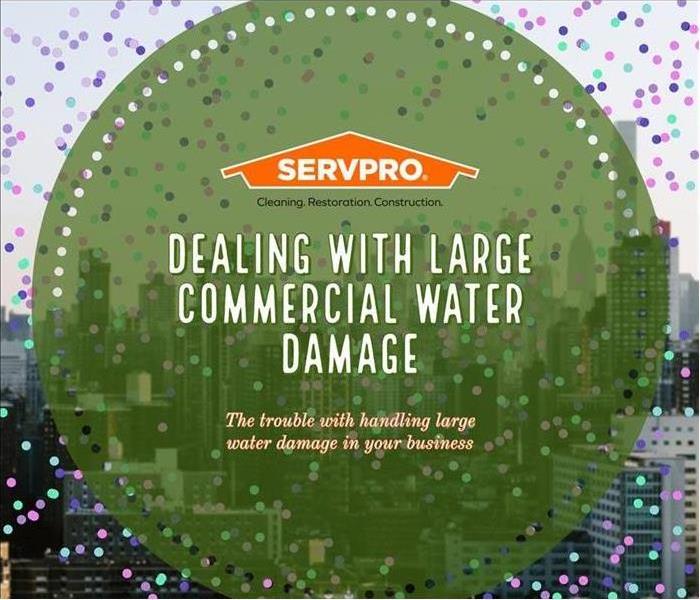 Large water loss to your business is no fun!
Large water loss to your business is no fun!
When it comes to commercial water damage, bigger is always worse. Commercial buildings are more susceptible than residential homes due to having more water lines for sprinklers, bathrooms, faucets, etc. These water lines are also not routinely used and therefore are more susceptible to leaks/breaks. When a water line in a commercial property breaks, it can be disastrous.
Large commercial water damage can be especially disastrous if it happens on an upper level, as water will run down into the levels below, causing damage all along the way.
Large scale damage like this is hard to mitigate as all floors need to be dried out and protected against mold growth. This can involve removing wet materials and contents or drying out and cleaning existing contents to prevent replacement.
When drying out a large, multi-story area, you need to have lots of equipment and personnel to handle the job. At SERVPRO of Bismarck, we have a large, highly trained crew that specializes in handling large commercial losses. Our corporate playbook is used to make sure timelines are being met, work is completed up the highest standards, and expenses are being kept in check. SERVPRO is one of the top industry leaders in large loss restoration and SERVPRO of Bismarck strives to keep up that reputation.
Large water losses can be devastating for a business. With SERVPRO of Bismarck we have the right equipment, knowledge, and people to get the job done right.
Dealing with Mold
8/29/2022 (Permalink)
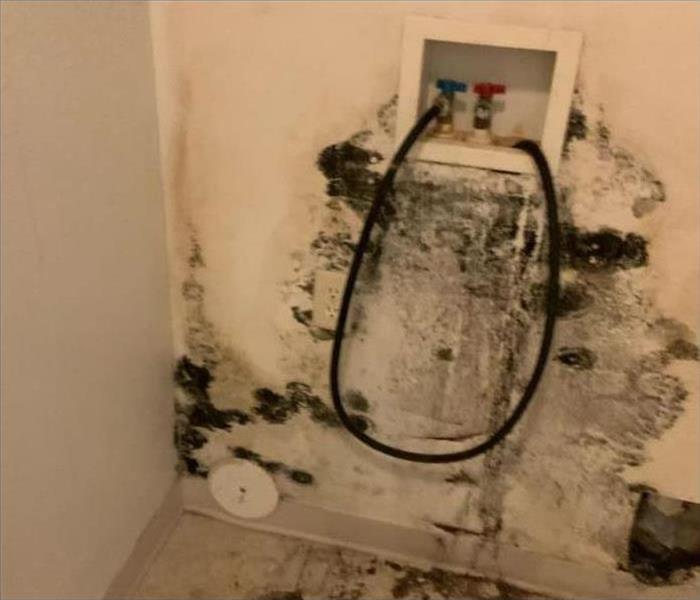 Mold growth can grow behind your washing machine!
Mold growth can grow behind your washing machine!
Mold is a mysterious and frightening problem to deal with, especially if you're not sure how to get rid of it. There are many different types of mold that can be found inside your home when you least expect it. Some types of mold are more harmful than others, so it's important to know what you're dealing with before trying to clean up the mess. In this guide we'll walk through the steps for cleaning up a small or medium size problem first, then expand outwards from there as needed!
Step 1. Check for Mold
The first step in dealing with mold is to find it. Mold starts growing when there is dampness and darkness, so look in the bathrooms, kitchens, laundry rooms and basements of your home. If you have an attic or crawl space that doesn't get much natural light, check these areas too. Be sure to check for black spots on pipes or walls as well as blue or green streaks on ceilings and walls.
Step 2. Identify the Problem
Mold can be found in many places. It can be the result of a water leak, and it often occurs in the bathroom, kitchen, or other areas where moisture is common. If there is mold anywhere in your home, you need to take steps quickly to remove as much of it as you can before it spreads further and makes its way into your walls and flooring.
Step 3. Decide How Much You Can Take on Yourself
If you're not sure about how to remove the mold, call a professional. It's always better to be safe than sorry when it comes to your health!
Step 4. Gather Your Tools and Supplies
- Goggles
- Paper mask (or bandana)
- Dust mask, disposable or reusable filter masks
- Rubber gloves, nitrile or latex
- Tissues and paper towels, preferably few-ply
Step 5. Use Separate Tools for Each Room
Now that you have a sense of the scope of the problem, it's time to decide what tools and products will be most helpful in removing mold from each room. This step might seem unnecessary, but trust us: its's not! The best way to avoid cross-contamination is by using different brushes or pads for each room.
Also, don't forget that some of your tools may need replacing now and then (especially if they've been exposed to moisture). You could also consider purchasing a few extra pieces which can be used throughout all rooms so as not to waste time by having to stop mid-job and go get another one.
Alternatively, if budget isn't an issue for you then there are other ways in which we can help prevent cross-contamination like using disposable wipes instead of rags or cloths (which may carry residual mold spores).
You'll also need a big bucket to mix the solution in and a spray bottle to apply it with, unless you're using premixed products
We recommend using an inexpensive 5-gallon paint bucket ($8) for mixing the solution. You can get away with smaller buckets if your room is smaller than 100 square feet or so, but larger ones are needed for larger rooms because they will allow you to mix up more product at once. The reason is that when using bleach, you have to add water slowly while stirring constantly until all of the bleach has been diluted into an even mixture. If the bucket is too small, then there won't be enough room for this process and some of your mixture may not get fully diluted before sprayed onto surfaces in your home (and may end up causing damage because it contains un-diluted bleach).
Step 6: Cleaning and Disinfecting
Once you've identified the moldy area, it's time to clean it. Mix a solution of one part bleach to 10 parts water in a spray bottle, then apply the solution directly to the moldy area using a paper towel or cloth. Let it sit for five minutes, then wipe clean with a second dry cloth.
Step 7: Deodorize and Prevent Future Mold Growth
To deodorize the area, you can use bleach and water. Start by rinsing the area with clean water, then apply a mixture of one cup of household chlorine bleach to 1 gallon of water. Let this sit for at least 5 minutes before wiping up any excess solution. For best results, allow it to dry completely before using your space again.
If your mold problem is particularly severe or if it did not go away after cleaning (or if you have another type of resistant mold), bring in professionals who specialize in removing toxic molds from houses such as SERVPRO of Bismarck; our experts will be able to asses whether any additional steps are necessary.
In addition to cleaning the affects area(s) in your home thoroughly, there are several other things that can help prevent future mold growth:
- Use a dehumidifier when possible and/or open windows during dry spells (e.g., when it's raining outside). This will help keep humidity levels low enough for most molds not to grow inside buildings or homes where they otherwise would thrive on moist surfaces such as walls or ceilings - but take care not to overdo it because too much moisture removal may cause condensation problems elsewhere within your building! If possible, use both methods together; one without support from another approach will likely fail due towards lackadaisical results since nothing else exists which would serve as extra support aside from maybe frequent vacuuming maintenance schedule services.
Mold growth is:
- Unsightly
- Expensive
- Hazardous to your health
- Something that must be dealt with immediately!
If you're dealing with mold, it's important to act quickly and get rid of it as soon as possible. Remember that there are many different types of mold out there, so make sure you know what kind your home or office building has before starting any cleanup process!
Tips for Cleaning Up Water Damage in Your Home
8/29/2022 (Permalink)
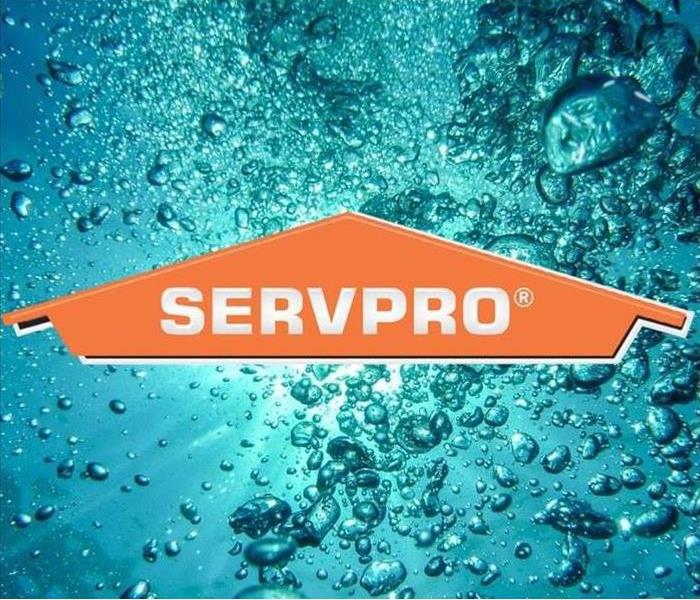 SERVPRO of Bismarck is "here to help".
SERVPRO of Bismarck is "here to help".
It can happen in an instant: A pipe bursts, flooding your home. It's a nightmare scenario for homeowners and renters alike, but it's not all doom and gloom. With the right knowledge and preparation, you may be able to save some of your belongings from water damage. Here are five tips on cleaning up water damage in your home:
Do not enter affected areas if electrical outlets, switches, circuit breakers and electrical equipment are exposed to water. Always avoid electrical shock hazard.
Once you're sure the electrical power has been turned off, do not enter areas where you can see or suspect water damage to wiring and equipment. Water may be hiding behind walls and in other places that are hard to see, so always assume there is a risk of electrical shock when working in such conditions.
Shocking yourself on an exposed wire could lead to a heart attack or even death. Call a professional who knows how to restore lost power safely.
Don't try using a wet vacuum cleaner because it can cause electrocution and burn out the motor on your machine. If you own a shop vac (which is not recommended) make sure that it's unplugged before attempting use if possible since there's less chance for electrocution that way, but don't rely on this method exclusively since most shop vac have motors with very little insulation between them that still could cause problems if submerged in water for long periods of time - especially salt water which conducts electricity much easier then fresh!
Do not use your household vacuum cleaner to remove water; this could cause electrical shock or damage to the vacuum cleaner.
If your home has been affected by floodwaters, do not use your household vacuum cleaner to remove water; this could cause electrical shock or damage to the vacuum cleaner. Instead, use a wet/dry vac. Remove water from the affected area as quickly as possible and then call in a professional.
Do not turn on ceiling fixtures if ceiling is wet, and keep out of rooms where ceilings are sagging from retained water.
If you have any ceiling fixtures in your home, don't turn them on if the ceilings are still wet. You could cause a short circuit and cause yourself more damage. If it has been a few hours or longer, you can safely turn on ceiling lights without causing any harm to yourself or your home.
If you see that one side of the ceiling is sagging due to retained water from the flood, stay out of that room until it's fixed.
Avoid contaminated objects, including soaked furniture and debris. Cover your nose and mouth with a cold cloth or dust mask when entering an area with a strong odor of gas or chemicals.
- Don't enter the area if electrical outlets, switches, circuit breakers or electrical equipment are exposed to water
- Don't use your household vacuum to remove water
- Don't turn on ceiling fixtures if ceiling is wet
- Don't enter areas where ceilings are sagging
Water damage can occur in your home at any time, but knowing what you should do can save you valuable time and money!
Water damage is one of the most common reasons for a home inspection. Many homes are built on stone foundations and have basements that are below ground level, meaning water can enter through cracks in the foundation or where pipes enter the basement ceiling/floor. Water leaks from plumbing fixtures such as toilets and faucets can also cause problems if left unattended for too long.
The best thing to when it comes to water damage is prevention. That means checking regularly to make sure all drains are clear of debris or hair clogs which may prevent them from draining properly, keeping your gutters clean so they catch falling rainwater and directing it away from your foundation before it has a chance to seep into cracks or leaky windowsills around doors leading outside (if left unchecked this type of problem could lead not only into other rooms but also outdoors. Ensuring all windowsills aren't cracked before replacing them with new ones so no more moisture get trapped inside after being exposed directly under bright sunlight all day long (this will help keep mold growth under control).
If you have any questions, please feel free to contact us at any time! SERVPRO of Bismarck is always happy to help out our customers with their home projects!
Tips for Reducing Fire and Smoke Damage
8/29/2022 (Permalink)
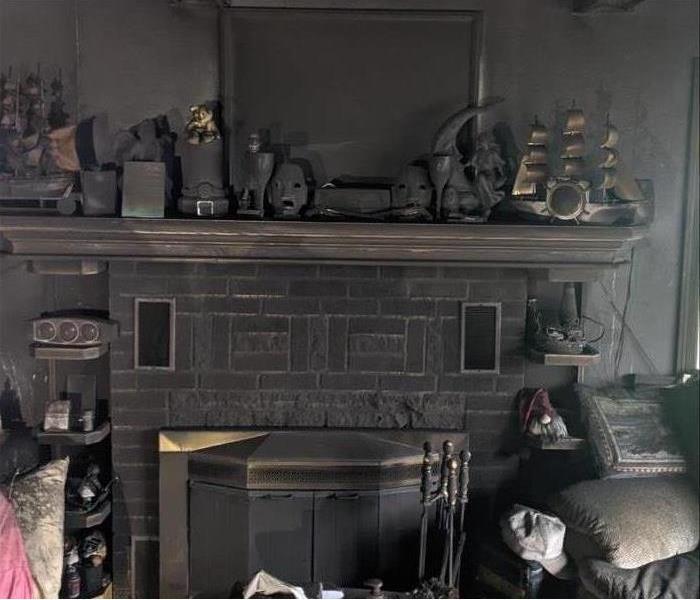 Extensive fire and soot damage before SERVPRO of Bismarck arrives
Extensive fire and soot damage before SERVPRO of Bismarck arrives
No one wants to think about the disaster that a fire has caused to their home, let alone the damage that still could happen. Here are some tips for minimizing it:
- Limit movement in your home to prevent the soot particles from being embedded into your furniture and carpets.
- Keep hands clean! Soot on your hands can further damage any items that are touched.
- Place dry towels or old linens on any furniture, rugs, or high traffic areas in your home.
- Let SERVPRO of Bismarck take care of the rest!
Our highly trained Fire Restoration Technicians are there and ready to help you get your home back into pre-fire shape, with less disruption to your home.
Let SERVPRO of Bismarck:
- Use special equipment to remove any remaining soot from the walls, ceilings and furniture.
- Get rid of any lingering odors by using industrial air scrubbers and fogging equipment.
- Restore any carpets or drywall or paint in areas that might need a touch-up.
The time after a fire can be scary and confusing, so let SERVPRO of Bismarck professionals help get your home back into shape.
How to Safely Put Out an Oven Fire
8/29/2022 (Permalink)
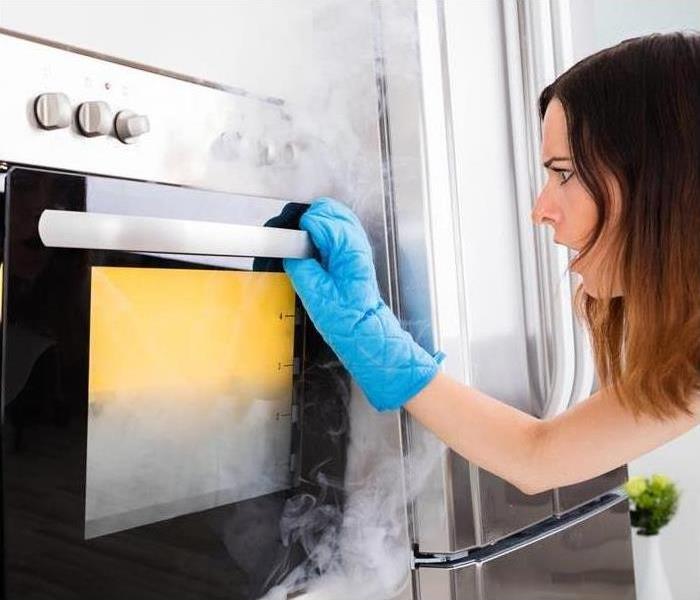 A small spark can cause a big issue!
A small spark can cause a big issue!
Picture this: You're happily cooking pancakes on a Saturday morning for your kids and the bacon is sizzling away in the oven. You HAD to get the kind with the extra fat because the kids like it better than too much actual meat. Your back is turned for one second and the next thing you know BAM! All that grease from the fatty bacon and a too hot oven has caused a fire! But don't panic! Follow these tips to help put it out and minimize the damage:
- DO NOT PUT WATER ON IT OR FAN IT. Water will instantly turn to steam and fanning it with a towel will only give the grease fire more oxygen to grow and spread to the towel which could cause burns.
- Keep the oven closed! Keeping the door shut will cut off oxygen and the fire will go out on its own.
- Turn off the oven fi you can to eliminate the heat source.
Well, the bacon is inedible, the pancakes are burned, the kids are thinking the whole thing is cool to watch, and you're just happy the fire is gone with minimal damage to the kitchen. Takeout anyone?
Smoke Odor in Your Home
8/29/2022 (Permalink)
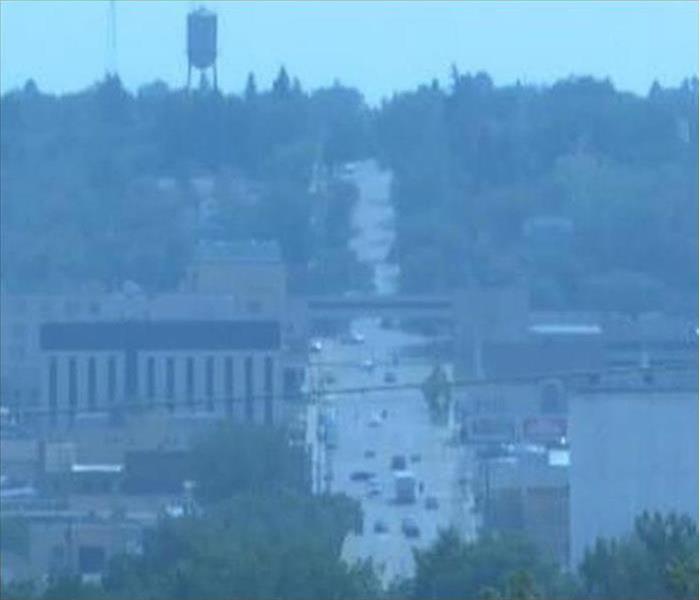 Smoke from wildfires covers this downtown
Smoke from wildfires covers this downtown
Fire season is upon us, and no one likes the smell of smoke everywhere you go outside. But your home should be a safe haven from the smoky smell, shouldn't it? That's not always the case. Smoke can linger for a long time if the wind isn't blowing hard enough to clear up most of the big stuff, which can cause the smoke to creep it's way into your home and into your carpets, walls and furniture. Now that smoky smell is stuck and plain air fresheners won't make it go away. That's why SERVPRO of Bismarck is her to get rid of it for you. Our trained technicians have access to several odor removal products capable of penetrating surfaces to neutralize the odor thoroughly.
Leave the smoke smell outside, and leave your home smelling smoke free with SERVPRO of Bismarck.
Water Damage Safety Tips After a Storm
8/29/2022 (Permalink)
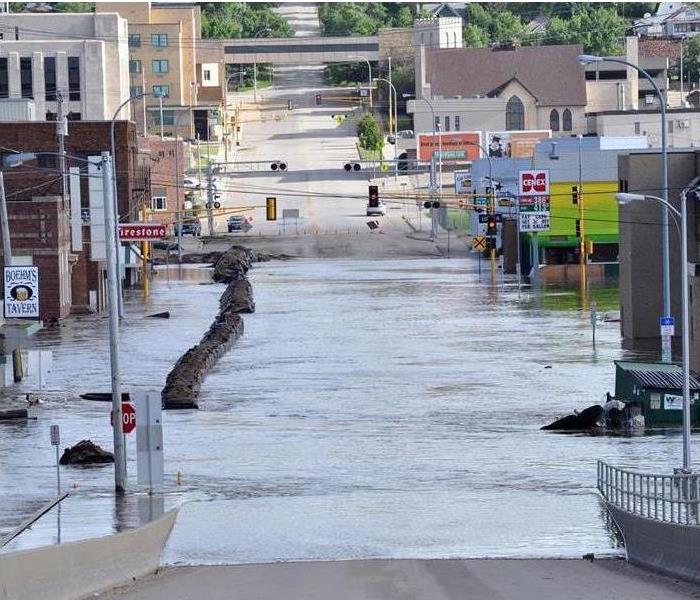 Souris River flood of 2011
Souris River flood of 2011
Heavy rain fall from massive summer storms can easily cause flooding outside and inside your home. After any water damage situation, you primary focus should be safety first. Here are some safety tips to follow until help arrives:
- Is it safe to stay inside the house?
- Electrical sand "slip and fall" hazards are some of the prevalent concerns.
- Only do activities that are safe for you to preform.
- Wet materials can be very heavy. Be careful!
What to Do After Flooding
- Remove excess water by mopping and blotting.
- Wipe excess water from wood furniture after removal of lamps and tabletop items.
- Remove and prop up wet upholstery and cushions
- Place aluminum foil or wood blocks between furniture legs and wet carpeting.
- Turn air conditioning on for maximum drying during the summer months.
- Remove colored rugs from wet carpeting.
- Remove art objects to a safe, dry place.
- Gather loose items from floors.
What NOT to Do After Flooding
- Don't leave wet fabrics in place. Hang furs and leather goods.
- Don't leave books, magazines, or other colored items on wet carpet or floors.
- Don't use your household vacuum cleaner to remove water.
- Don't use the television or other household appliances.
- Don't turn on ceiling fixtures if the ceiling is wet, and keep out of rooms where the ceilings are sagging.
For any water damage caused by a storm, call SERVPRO of Bismarck to help you clean up the mess and make it feel "Like it never even happened".
Dealing with Storm Damage at Your Commercial Property
8/29/2022 (Permalink)
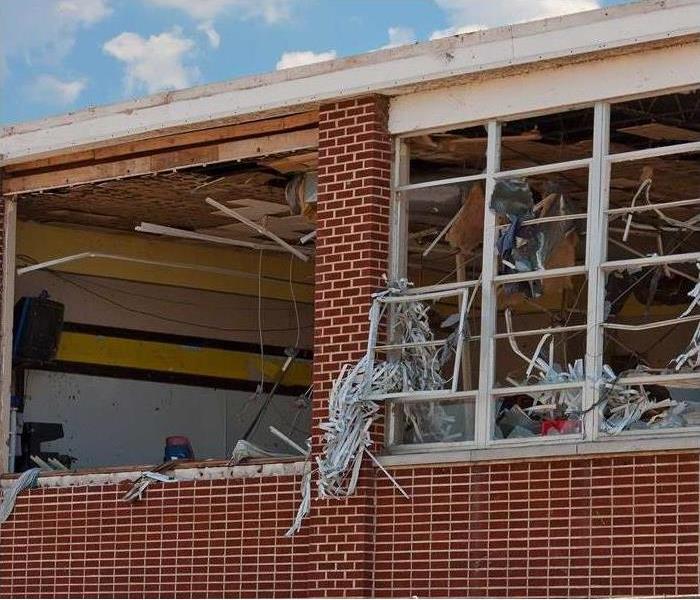 The windows of this building were broken due to high winds in a storm
The windows of this building were broken due to high winds in a storm
Storms and inclement weather can be devastating to any business. Wind damage, heavy rain, and flooding can occur suddenly and can cause substantial damage in a matter of minutes. There is never a convenient time for flooding or storm damage to strike your business. Every hour spent cleaning up is an hour lost of revenue and productivity. So when an emergency situation arises in your business, give us a call and we will be there fast with the help you need.
SERVPRO of Bismarck has the training, experience, and equipment to handle any large commercial storm or water damage emergencies. Regardless of your property type or size, we will respond quickly to clean up your property and manage the restoration project to its completion.
SERVPRO of Bismarck: Faster to Any Size Disaster
8/29/2022 (Permalink)
Residential and Commercial Restoration and Cleaning Services
SERVPRO of Bismarck is dedicated to providing 24-hour emergency service. We have highly trained experts in not only water mitigation and fire restoration, but also mold remediation and emergency storm clean up. We pride ourselves on being "Faster to any sized disaster". Our expertly trained technicians can respond immediately to your small residential or large commercial emergency. We work hard to arrive promptly and work efficiently to properly restore your property!
Your Bismarck home is our priority! When it comes to disaster clean up we are certified and experienced and "here to help". Give us a call and we'll be ready to clean up your home or business and make it "Like it never even happened".
Why Choose SERVPRO of Bismarck for Storm Damage Cleanup?
8/29/2022 (Permalink)
We're Faster to Any Size Disaster
We're dedicated to responding immediately to water and storm damage emergencies. A fast response lessens the damage, limits further damage, and reduces the cost.
We're Highly Trained Storm Damage Specialists
As leaders in the storm and water damage industry, we have advanced training and expertise, not to mention a ton of hands-on experience. We use this training and experience to quickly dry your home and restore it back to pre-storm condition.
- Water Damage Restoration Technician
- Applied Structural Drying Technician
We Have the Resources to Handle Storms and Disasters
We can scale our resources to handle any size storm or disaster. We can access resources from a network of 2,010 franchises across the country and elite Disaster Recovery Teams strategically located throughout the country.
Why You Should Purchase a Dehumidifier
8/26/2022 (Permalink)
 Get a dehumidifier to protect your home from mold
Get a dehumidifier to protect your home from mold
When cleaning up water damage, commercial-grade dehumidifiers are excellent for sucking excess moisture from the air, helping to dry out the area and prevent further damage. While extraction of the standing water take first priority, dehumidification prevents a variety of further problems such as improving air quality and reducing mold growth. If you don't already have a dehumidifier, here are some benefits of why you should get one.
As mentioned in the paragraph above, the benefit of cleaner air is huge. Overly moist air is susceptible to catching a variety of airborne particles contaminating your air. This could include dust, dead skin cells, and mold spores. Dehumidification reduces the number of particles in the air, making it easier and better for breathing.
Reducing moisture and maintaining clearer air is one of the best ways to prevent mold growth in your home. Mold grows by finding a damp, wet environment and then releases spores into the air which spread throughout your home until they find another surface to grow on. One of the reasons we at SERVPRO of Bismarck dehumidify areas that have been affected by water loss is to reduce the chance of mold growth.
While our commercial-grade dehumidifiers are excellent at removing large amounts of moisture from the air in homes and businesses, they are not affordable for the average person. However, many residential dehumidifiers are available that can be placed in a basement, or other room, and are specifically designed for a space of that size. Home dehumidifiers are affordable for most families and can be found in a variety of stores both online and in-person stores. If you have been considering buying a dehumidifier, there is no better time than now to make a purchase.
Spring Maintenance Checklist for Your Commercial Property
8/26/2022 (Permalink)
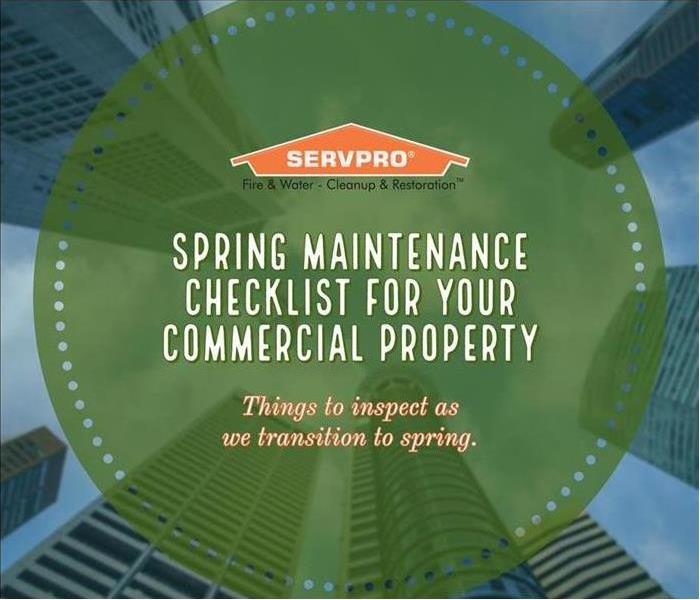 Keep your commercial property in tip-top shape!
Keep your commercial property in tip-top shape!
As we begin to transition from cold weather temperatures to warmer spring weather, here is a checklist of points on your property to check for winter damage and begin planning repairs. Compared to our typical North Dakota winter, this one has been pretty mild. But, there was still a handful of weather events that had the potential for major damage. As our state continues thawing out, here are some things to check over and ensure for quality.
We are currently in a dangerous time of the year as daytime temperatures begin regularly going over 32 degrees, and the nighttime temperatures continue to dip well below the freezing point. The cycle of thawing and freezing can have a harsh effect on many parts of your building. Things like pipes, window seals, and drainage systems can become blocked or damaged. These should be constantly maintained throughout the year with a heavy focus during the winter and early spring months.
Additionally, here are things to look for during spring inspection:
- Pipes with minimal water flow
- Poor drainage pipes
- Cracks in the foundation, walkways, parking lots and patios
- Broken or loose pavement
- Sink holes
- Missing roof shingles
- Separation or erosion in siding and masonry
- Rotting or loose boards
- Chipped paint
- Broken, cracked, or leaky windows
- Landscaping debris such as leaves or branches
If you notice any of the damages listed above, you should start making preparations for repairs. Additionally, be sure to contact your insurance company if you suspect the cause of damage. While you may not have noticed the damage until days, weeks, or months later, it is still possible that you have not yet exceeded the timeline to file an insurance claim. For example, if a windstorm caused damage to your roof, but you were unable to get a roof inspection due to the cold, slippery conditions, you can still file a claim and be covered. When in doubt it never hurts to ask your insurance company if your damage is covered.
5 Tips for Spring Cleaning
8/26/2022 (Permalink)
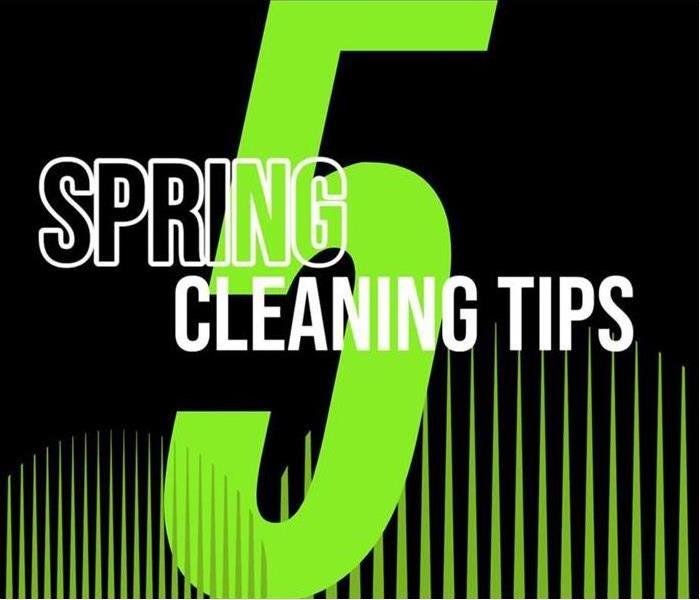 Spring cleaning to keep your home looking great!
Spring cleaning to keep your home looking great!
As the weather gets warmer and we make our way back into spring, here are five quick cleaning tips to make sure your spring cleaning goes smooth and easy this year.
Use Minimum Products
When preparing to start your cleaning, use as few products as possible. Minimizing your cleaning product inventory creates less clutter and confusion. Most of the time, you will just need a good all-purpose cleaner and some rags. Instead of overwhelming yourself with a wide range of cleaners for floors, wooden furniture and appliances, use an all-purpose cleaner and save time switching between different products.
Create a Plan
Organize your home and assign dates to clean different rooms and areas. Begin by making a list of all rooms in your home, including outside. Under every room, write down what needs to be cleaned. It may help to walkthrough every room and write out the list. Once this is done, including everything that needs to be done outside, assign dates to every room, schedule bigger projects for weekends and smaller ones for afternoons during the work week. This way you have a plan and timeline to get everything done.
Clean Out the Cabinets!
Spring cleaning is not just about what you can see. Declutter cabinets, fridges, drawers, etc. This will help your home get organized more than anything else. Everything might be clean now, but when you have to start digging through drawers and boxes to find something, your home will quickly become a mess again. Consider purchasing drawer and fridge organizers to help contain the clutter.
Use Lemons!
Lemons work great for cleaning all sorts of surfaces. From faucets to tabletops, lemons are a great cleaning product. To clean your microwave, squeeze a lemon into a bowl of 1/2 cups - 3 cups of water and leave the lemon in the water. Microwave for about 3 minutes or until steamy. When done, just wipe out the grease from the inside! Lemons are a natural, cheap, and versatile tool to use for cleaning hard to clean areas.
Wash Windows on a Cloudy Day
When the sun is bright and shining, it can leave streaks from drying out too fast. Instead, wait until it is either cloudy or the sun is not directly shining on the windows, such as in the evening. This goes for mirrors too. Turn off any bright lights and use ambient lighting to leave a streak-less clean on these surfaces.
Places to Not Forget
While cleaning, don't forget to clean out these easy-to-forget places as you complete your spring cleaning!
- Wipe down kitchen cabinets
- Stove top fans
- Knife block
- Ceiling fans
- Crumbs in toaster
- Toothbrush holder
Fire at a Bismarck Hotel
8/26/2022 (Permalink)
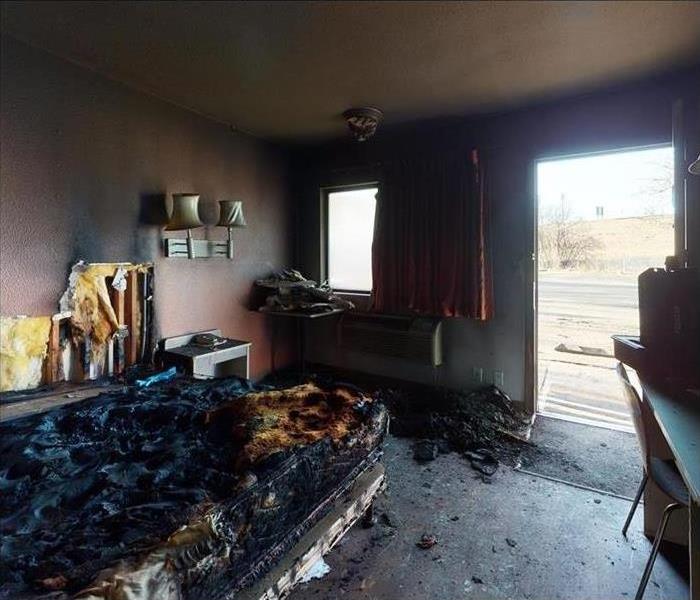 Image captured from our 3D Matterport™ camera
Image captured from our 3D Matterport™ camera
Although you may expect to have problems when you stay at a hotel, you usually have an idea of what those problems will be. A bad mattress, poor breakfast, or loud neighbors. However, you do not expect a fire to ruin your stay. This is what happened at this Bismarck hotel when a case of arson left behind a sooty, smoky room.
Staying at a hotel is supposed a relaxing experience. Whether you are on a trip to relax or for work, the last thing you expect to have is a fire within the building. Thankfully, nobody was harmed, and the fire was contained to the one room.
This was one of the first jobs we used our new 3D Matterport™ camera to document the damage and create a 3D model. Having a 3D model will allow us to have the most accurate documentation of the job site and easy communication between our staff, the hotel managers, and their insurance providers. This will allow us to have quicker and better information and ensure the property gets cleaned faster, allowing the hotel to reopen that room for guests again.
Types of Spring Weather to Be Prepared For
8/26/2022 (Permalink)
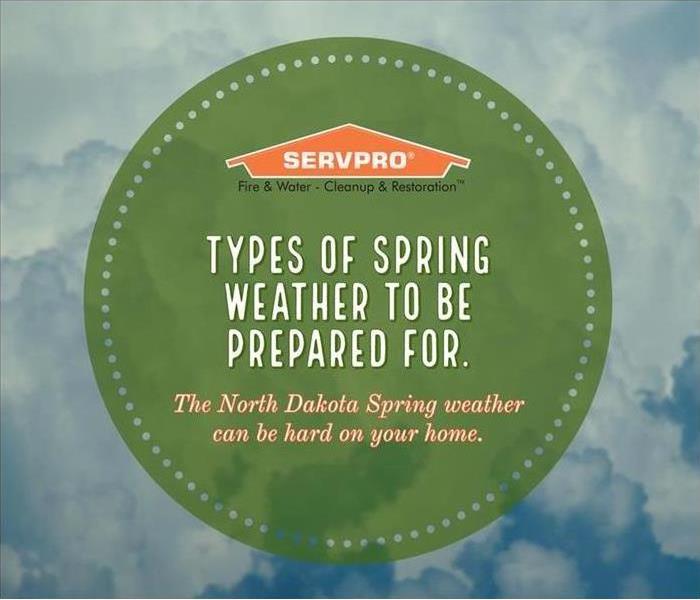 Watch out for weather this spring!
Watch out for weather this spring!
As we make our way closer to summer, it is important to not forget about the possibility of spring storms in our area. North Dakota can experience a variety of different weather patterns at this time of year. Here are just a few.
Blizzards
Although we have had a very mild winter, there is always the possibility of a spring blizzard in and around Bismarck. Overnight, there can be a dramatic decrease in temperature and accumulation of moisture. This can be hard on your home, and you should always be watching and prepared for when a cold front is expected.
Thunderstorms
Spring is the primetime for sudden thunderstorms. These can have a tremendous impact on your home, from flying debris, to ripping off siding and damaging your roof. In addition, downpouring rain can be a hazard if gutters are not properly cleaned out or if there is a leak where water can enter your home.
Heat and Fire Danger
As we have seen for the last few weeks, dry temperatures can cause potential risks for heat and fire damage. The dry environment creates the perfect condition for grass fires which can cause damage to dozens or even hundreds of homes if not contained. Also, the heat can be dangerous for your personal health and that of young children and senior citizens. Be sure that if you are ever out in the heat for long periods of time to bring plenty of water and stay hydrated.
High Winds
High winds are almost a staple of North Dakota. Although we are used to high gusts, it is still important to prepare for them. The biggest concern with high winds is damage to siding, roofing materials, and throwing debris into your home. Cleaning your yard and removing potential flying objects when a storm is expected can guard against damage. While there is little you can do to prevent wind from removing siding, fencing, or roofing. Other than proper, secure installation, you can make sure your insurance policy covers against that damage.
Our 3D Matterport Camera
8/26/2022 (Permalink)
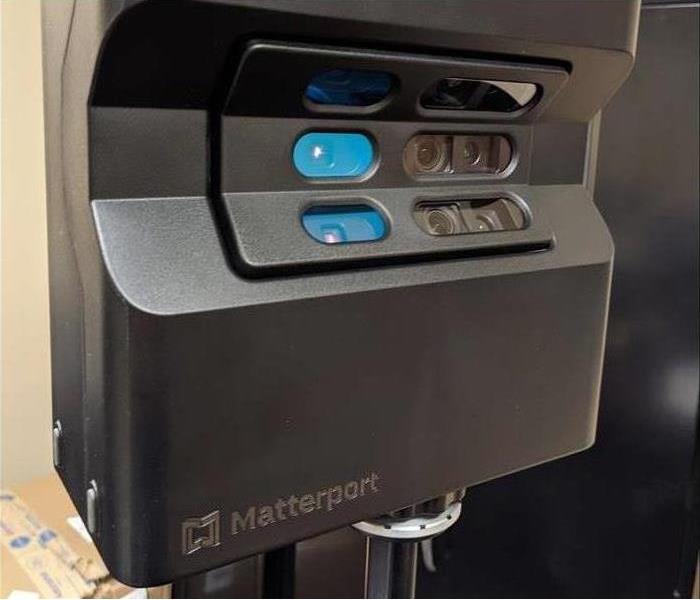 Our New Matterport Camera
Our New Matterport Camera
Continuing to strive to improve our service, SERVPRO of Bismarck purchased a 3D Matterport camera. This new technology will provide property owners and insurance companies with incredibly accurate measurements and 3D images for all property losses while we work to restore the damaged property.
Using Matterport, we are going to have accurate, updateable documentation throughout the entirety of the job duration. From our initial inspection, to our final walkthrough. This will ensure the most comprehensive preloss asset documentation and risk management with the digital twin that allows for more informed and accurate underwriting practices.
- Unbeatable documentation accuracy for higher quality assessments.
- Add policy, work approvals, and claims notes directly into the 3D model.
- Complete detailed measurements of affected area with 3D imaging to ensure quality.
With 3D models, timelines for completing jobs will decrease exponentially. This will allow quicker communication between the property owner, their insurance company, and us, here at SERVPRO of Bismarck. Allowing for the work to be done quicker, better, and with everyone on the same page.
Along with the 3D images model, Matterport also can create an accurate floor plan sketch. This sketch can be uploaded to Xactimate® to send out estimates with all the information needed right in the sketch and models. This will speed up time for claims to be paid out and job losses to be processed.
SERVPRO of Bismarck is excited to begin training on Matterport systems and programs. We expect to begin implementing Matterport in our work soon and look forward to using it to help our North Dakota communities recover from whatever disaster they may experience.
Our Six-Step Drying Process
8/26/2022 (Permalink)
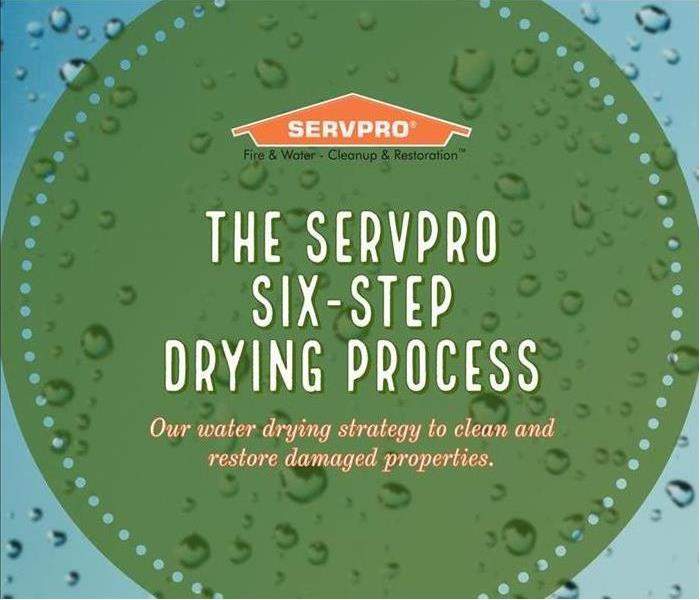 Check our thorough 6-step drying process
Check our thorough 6-step drying process
When North Dakotans are confronted with water damage, SERVPRO is the most trusted cleaning and restoration company in the state. This is due, in part, to our Six-Step Recovery Process used to ensure a property is completely dried and restored after suffering from water damage. Whether it is from broken pipes, sewer backups, or appliance leaks, we use the same process to ensure quality results.
Step 1. Emergency Contact
The first step is when we get the call. Whether it is directly directly from the property owner or from an insurance professional, we get all of the details needed to begin our response. This includes detail about the loss, contact and address information, and what has been affected by the damage. This gives our team the best idea of what equipment and specially trained technicians to send to begin response.
Step 2. Inspection and Damage Assessment
Once the call has been received, an inspection will be scheduled and SERVPRO technicians will be sent to assess the damage and begin work if approved by the property owner and their insurance. In most cases, a property owners insurance policy will cover initial services to mitigate damage, such as water extraction and removal. This means that our technicians can begin work immediately without needing to get an estimate approved by the insurance provider.
Step 3. Water Removal/Water Extraction
The water process begins with packing out any materials to prevent further damage. This could be furniture or boxed items, or anything that can be moved to help our technicians best begin water removal.
Once items have been removed, powerful pumps and truck-mounted extraction wands are used to remove any existing water. This powerful suction technology will remove most of the moisture from affected flooring, making the drying process go quicker and smoother.
Step 4. Drying and Dehumidification
Once the excess water has been removed, the floors and walls may appear dry, but a quick inspection will reveal that they are wet to the touch. Nearly all building materials, like wood, drywall, and flooring materials, and porous and therefore retain water. This retained water can cause the materials to break down, warp, or cause mold damage.
Using commercial grade dehumidifiers and high- volume air removers, we begin drying out the area while monitoring the progress with handheld moisture meters. For most jobs, the drying process will be complete in 1-3 days, depending on the size and amount of moisture in the materials. After drying is complete, the final repairs can be scheduled and made.
Step 5. Cleaning and Repair
After drying is finished, cleaning and repair takes place. This varies from job to job but could involve cleaning off affected contents such as clothes, furniture, or other belongings. Additionally, for water damage, the area is cleaned and sanitized with special anti-microbial agents to prevent mold growth. Also, deodorizing might take place if there is a smell left over from the damage.
When stopping water damage, this can mean cutting into walls to stop further damage or to remove wet materials. After the area has been dried out, any leftover debris is removed and documented for the restoration repairs.
Step 6. Restoration
The final step is our recovery process in the restoration. While we try to save as much of the existing property as possible, oftentimes some things are unsalvageable. In these cases, our Build-Back department works with your insurance provider to restore the property to the condition it was in prior to the loss.
This can be as simple as replacing damaged carpet, or as extensive as a complete tear down and reconstruction of the damaged area. Whether it is a complete bathroom restoration, or a simple wall replacement, we work with the insurance provider every step of the way to get approvals based on existing policies to get a seamless restoration completed.
Why a Fire Loss Call May Turn Into a Water Damage Claim
8/26/2022 (Permalink)
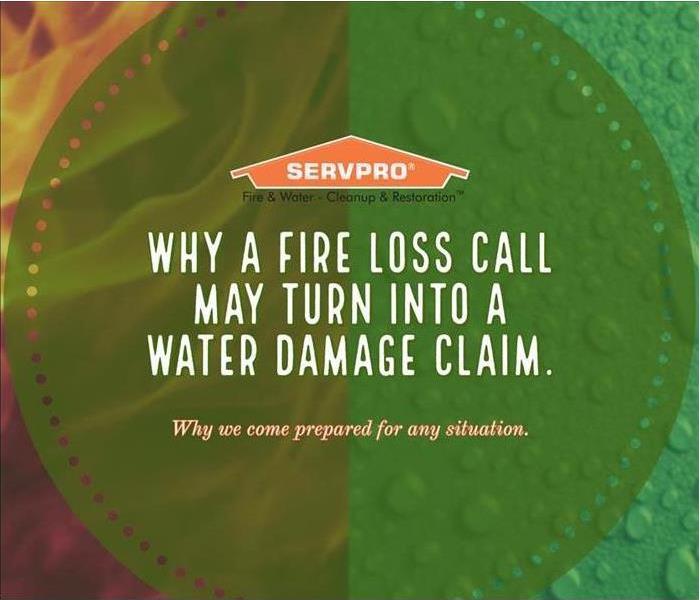 Fire loss may turn into water damage
Fire loss may turn into water damage
While it may seem obvious when we get a fire loss claim that there will be typical signs of fire damage, burnt materials, soot, and smoke residue everywhere, you might be surprised to learn that we usually find water damage in these instances too. Whether it is a big or small fire, water damage can often come with it, creating an even larger mess and problem to clean up.
Almost all commercial buildings today have a built-in fire suppression system, like overhead sprinklers. When there is a fire, these sprinklers extinguish the blaze, but in doing so, flood the property with hundreds or thousands of gallons of water. While hopefully these sprinklers prevent further fire damage, they leave behind a different problem, in the form of water damage. While the sprinklers prevent further damage and protect anyone in the building, the water needs to be cleaned immediately. The sprinkler water is clean, coming straight from the water main and therefore can cause minimal harm if extracted immediately, as opposed to dirty water which can leave behind germs and harmful bacteria.
In residential properties, while there may be no built-in sprinklers fire fighters often create water damage when extinguishing blazes. Using high powered hoses, modern fire fighters can pump hundreds of gallons of water into a home, leaving behind a wet mess in addition to whatever fire damage happened.
Water damage is far less deadly, and dirty, when compared with a large fire loss and can be mitigated faster as well. While we hope all fires can be put out quickly, whenever we get a call about fire loss, we come prepared for water damage as well.
Why You Should Call SERVPRO After a Bad Wind Storm
8/26/2022 (Permalink)
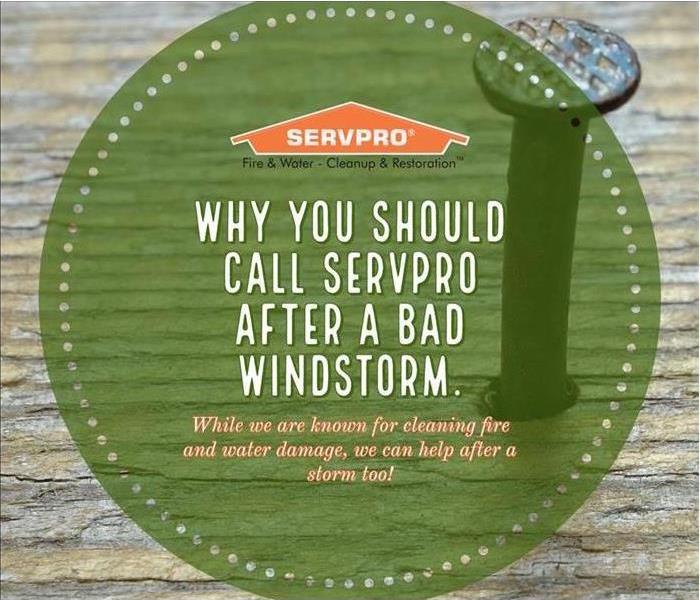 Let SERVPRO cleanup after a wind storm
Let SERVPRO cleanup after a wind storm
North Dakota weather can be extreme. From bitter cold winters, burning hot summers days, and crazy windstorms, we see it all. While SERVPRO may come to mind for repairing water damage from frozen pipe breaks or for fire damage caused during a hot, dry, summer fire, you may also call SERVPRO after a powerful wind storm.
During storms, wind can damage many important features of your home, including siding, roofing, and windows. After the storm passes, your home can become vulnerable to the outside elements unless quickly protected. If your home has broken windows, damaged roofing, or other damage from a storm, calling SERVPRO of Bismarck can save you time and effort with temporary repairs until a more permanent fix can be made. Whether it is boarding up windows, tarping roofs, or cleaning up damage in your yard. Give us a call, let us know what happened, and we will help you with whatever disaster might have struck.
Disaster in Velva After a Long Weekend
8/26/2022 (Permalink)
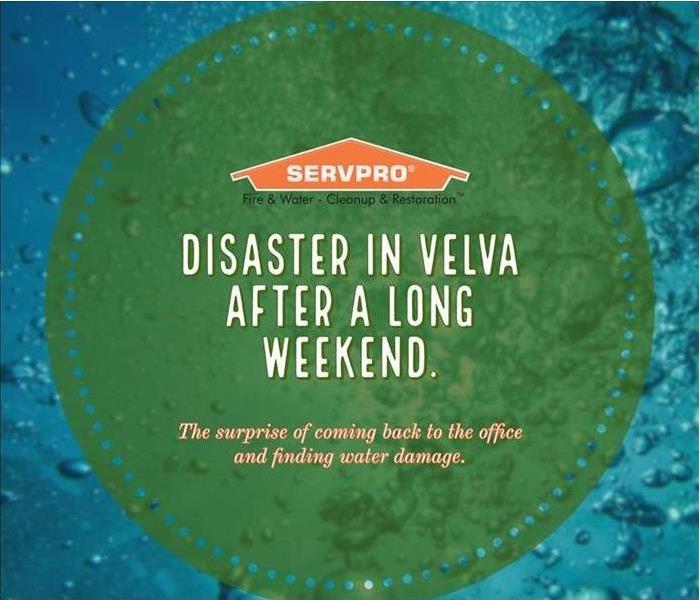 SERVPRO helped Velva City Hall get back in shape!
SERVPRO helped Velva City Hall get back in shape!
When city employees came back to work after a long weekend, there were stunned to find a wet mess throughout their office space. A pipe had burst and completely flooded half of the City Hall building.
After calling SERVPRO, technicians were on the site within two hours after the call and began extracting water from the rooms and removing restorable materials from the building. Additionally, they applied anti-microbial products to the affected flooring and walls to prevent mold growth. Technicians were able to answer all concerns that employees had and update the insurance professionals on the status of the work.
Once mitigation of the water damage was completed, reconstruction was scheduled and materials were ordered to begin the Build-Back work. This is a perfect case in why you never know what can happen over a long weekend, and why we will always be "here to help".
3 Things You Can Do Today to Prepare for a Summer Home Fire
8/26/2022 (Permalink)
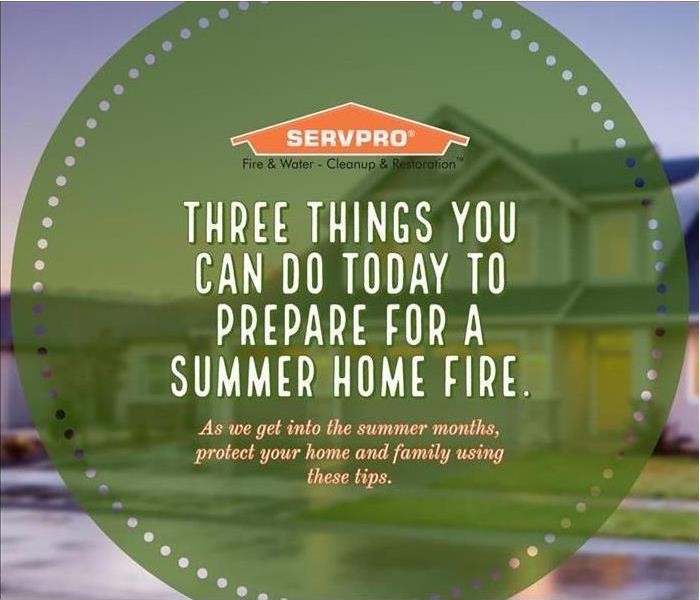 Be prepared for possible home fires
Be prepared for possible home fires
As we head into the summer months and the temperature starts heating up, now is a great time to make sure you're ready in case the unexpected happens. Summer is the busiest season for home fires to occur. Here are three things you can do today to make sure you are ready for a home fire.
Check Fire Extinguishers
Now is a great time to check your fire extinguishers and perhaps buy more if necessary. Check the gauge at the top of the extinguisher and make sure it is properly pressurized. If an extinguisher has no pressure, return it to the manufacturer or proper dealer and purchase a new one. Make sure priority rooms in your home are within reach of a fire extinguisher. This includes the kitchen, garage, basement, utility rooms, hallways, and any other room that could be susceptible to a fire. Remember to place your extinguishers around your home so that you will be able to reach one quickly and safely, without being cut off by a potential blaze.
Make an Escape Plan
Bring your whole family together for a reminder about the escape plan in case of a fire. Have a predetermined location for everyone to meet after they've left the house. This way, it reduces family members going back into the home to look for someone, which should never be done. In the plan, be sure to determine how every family member will get out, where to meet, and plans for afterward, such as friends or family to stay with and insurance members to call.
Check Smoke Alarms
Smoke alarms should be checked annually. This is a simple step that can be done to drastically help prevent fire damage and loss of life. Make sure the alarm is fully functional by pressing the test button until a sharp piercing noise can be heard. If no noise is made, replace the battery and try again. If there is still no noise, replace the whole unit.
As we head into the summer months, be sure to take steps to protect your home and family from an unexpected fire.
How SERVPRO Uses Technology to Stay Ahead of the Competition
8/26/2022 (Permalink)
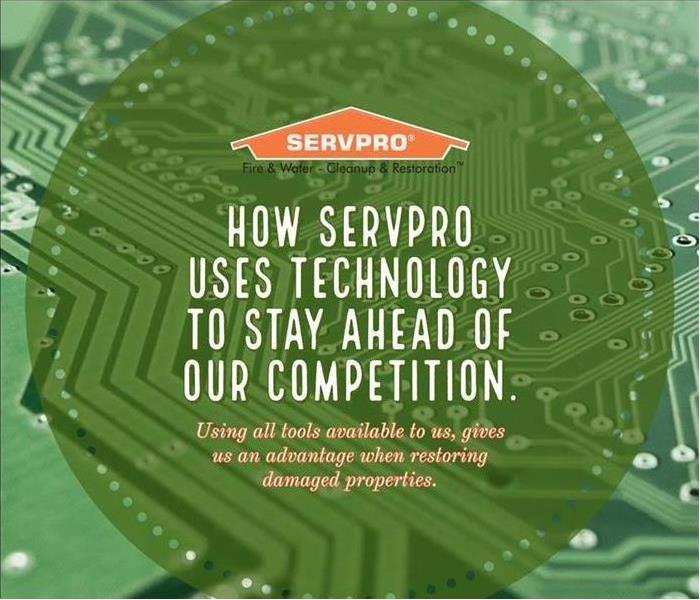 Check out our new tech!
Check out our new tech!
In an effort to constantly strive for improvement, SERVPRO of Bismarck tries to stay on the leading edge of new technologies to help us improve our work. We provide our employees the latest available tools to improve our overall efficiency and quality. Here are a few examples of the technology we use.
Xactimate
Xactimate is a national estimating software used by insurance adjusters. We use this software to make sure we have standardized, competitive prices as well as ease of communication when working with adjusters.
Matterport
Matterport is a 3D modeling and sketching software. This allows us to use 3D virtual models to document job sites. Using this, we can more accurately create estimates, enable quicker communication with insurance professionals and property owners.
Infrared Cameras
We use infrared cameras to detect moisture in walls, ceilings, and floors. These handheld cameras allow us to find water that is being held in wall, flooring, or ceilings. With a better idea of where the water is being trapped, we save time when extracting wet, affected materials with also having to replace less materials when we restore the site.
Moisture Meters
Moisture meters are handheld detection devices that, like infrared cameras, can be used to find the source of moisture or where water has spread. The difference between these and infrared cameras is that infrared cameras are used to scan an area where there is no known leakage to find a possible leak, while moisture meters are used to determine the spread of an already known leak.
These are just a few examples of some technology we use to be on the leading edge of restoration companies in North Dakota. Follow our Facebook page, SERVPRO of Bismarck, to see what other tools we use to stay ahead of the competition.
How Sprinkler Systems Work to Put Out Fires in Commercial Buildings
8/26/2022 (Permalink)
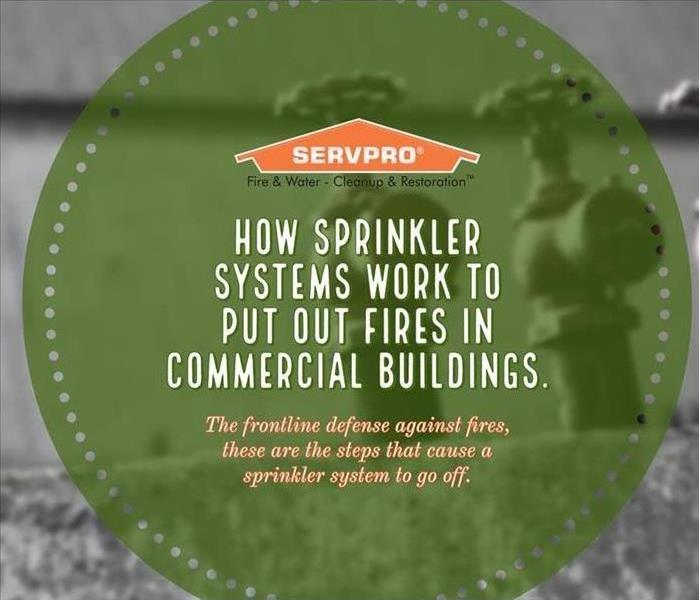 Facts about sprinkler systems
Facts about sprinkler systems
A staple of modern fire prevention, sprinkler systems are a modern marvel when it comes to protecting buildings, their assets, and the people who live and work inside of them. Sprinkler systems are highly sophisticated and have saved countless lives and properties since their implementation in the early 1800s. Below are three main steps that set off a sprinkler system.
1. A sprinkler head turns on when it detects high temperatures. Fire sprinklers turn when high heat triggers the system rather than being activated by smoke. Hot air rises during a fire and spreads across the ceiling until it reaches a sprinkler head and activates the fire suppression system. Many sprinkler head designs feature a glass bulb filled with a glycerin-based liquid that expands when it comes into contact with air between 135 and 165 degrees Fahrenheit. The liquid shatters the glass container when the surrounding air reaches temperatures in this range, activating the sprinkler head.
2. Sprinkler heads dispense pressurized water from the pipe system. Each fire sprinkler head is attached to a pipe that brings in water. When a sprinkler head becomes activated, a valve connected to the head opens and sends water out through the sprinkler head to douse the fire. Water pressure is important, as it causes water to spray out over a larger area.
3. Sprinkler heads function individually to limit water damage. Each sprinkler head in a sprinkler system functions separately. Many small fires can be extinguished with only one or two activated sprinkler heads. Sprinkler pose less of a water damage risk to a property than a fire hose. Some restoration specialists estimate that the average sprinkler system dispenses six times less water than a hose.
How to Inspect Your Roof for Damage After a Thunderstorm
8/26/2022 (Permalink)
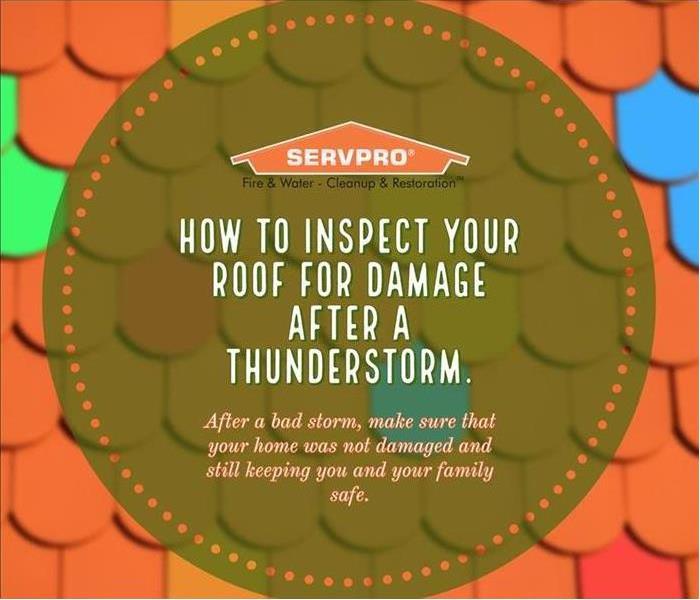 Make sure your roof is in good shape!
Make sure your roof is in good shape!
After a booming North Dakota thunderstorm, you might be concerned about damage to your home and especially your roof. After a storm, here are some tips for inspecting your roof for water damage so you can get it fixed before the next storm.
Look for Leaks
The most clear and obvious way to know if you have roof damage is if there is water leaking into your home. Look along the seams where the wall meets the ceiling, corners of rooms, and in the attic for any kind of moisture or dampness. If you find any, you will know where to make repairs and can help to mitigate against further damage.
Look on the Roof
If you fine no damage on the interior of your home, try getting up on the roof and looking for any breaks in shingles, projectile damage, or other cracks that may have opened in your roof. Carefully go over each section to find any kind of wind or water damage. Make sure any seals around grates, vents, or windows are intact and have no weathered.
The Garden Hose Test
The most thorough test you can do your roof is ensure there are no leaks is to test it out by simulating heavy rain conditions. With someone inside watching for leaks, pour water from the garden hose over sections of your roof to look for leaks. You can also do this to make sure your gutters are properly draining. This test will give you a firsthand look at how water is draining off your roof and let you know of any repairs that needs to be made.
If you do find any damage to your home or roof, immediately contact your home insurance provider and make sure to document any damage with pictures so that you can get a claim submitted for repair costs.
What Causes a Sewer Back Up?
8/26/2022 (Permalink)
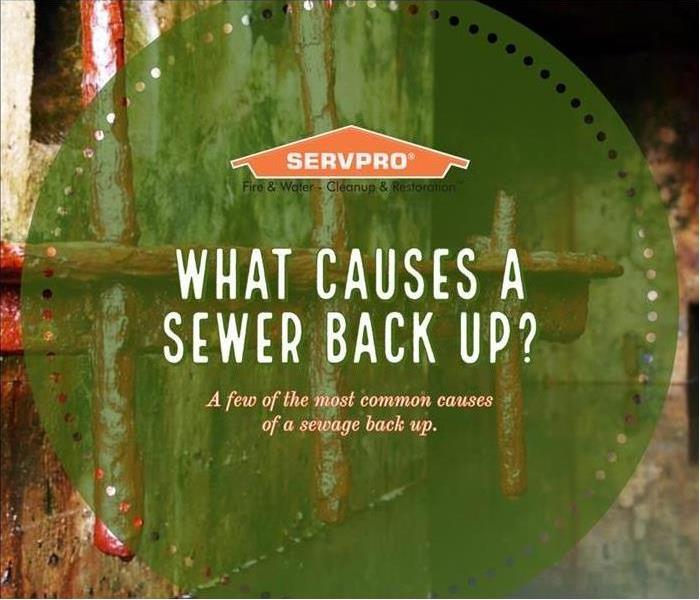 Sewer backups are nasty things to deal with!
Sewer backups are nasty things to deal with!
One of the common homeowner insurance claims are sewer backups. This ends up being a nasty, messy catastrophe in your home, but what is the cause of it? There are multitude of reasons why you could experience a sewage backup, but here are a couple of the most common.
Clogged Drains
Clogged drains are one of the most common reasons for a sewer backup. Improper use of toilets and sinks can cause a main sewer line to become clogged. Flushing cleaning wipes, diapers, napkins, and many other hygiene items can cause a sewer line to become clogged over time. Sewer lines are filled with a volatile combination of hair, soap, and dirty water. Adding things such as grease or excess kitchen waste can clog the drain and lead to a sewer backup.
Tree Roots
Sewer lines often run under front lawns and nearby tree roots can grow into and around the pipes. Trees have expansive root systems and even if the pipe itself is not near a tree, the roots can spread out and around the pipe.
Once a tree root has grown into a sewer line, the line will need to be replaced and often times the tree roots removed or trimmed down. This will be a big project involving digging into the ground and replacing the existing sewer lines.
Different Ways a Summer Storm Can Damage Your Home
8/26/2022 (Permalink)
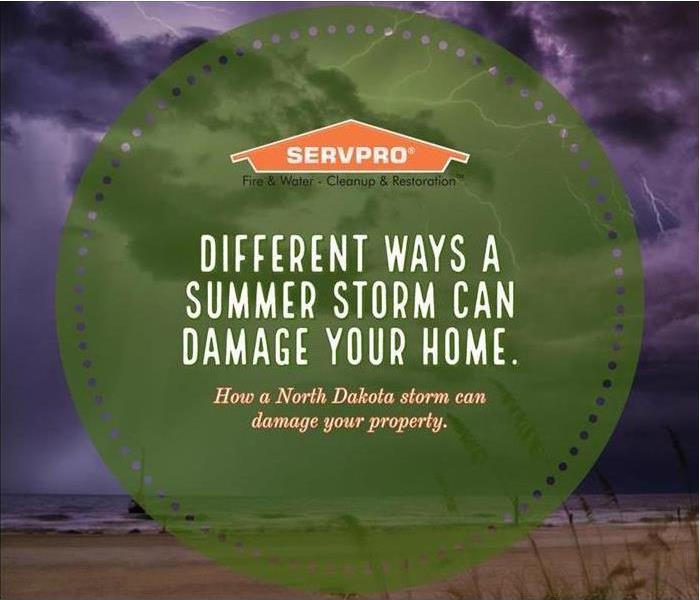 Protect your home against summer storms
Protect your home against summer storms
As we head into the summer months, North Dakota storms may be on their way that can cause damage to your home. While we have experienced a dry spring, you never know when a sudden storm could form in our area. Below are some different ways a storm can cause property damage.
Roof Damage
High winds and water are the perfect combination to damage your roof. Whether is is tearing off shingles or opening a crack that creates a leak, your roof is the first and foremost concern after a violent storm. Additionally, trees and branches could be brought down the storm, causing obviously devastating damage.
Siding
Similar to your roof, wind and rain can tear siding off your home or create leaks. After a storm, walk around the perimeter of your home and make sure nothing has come loose or been torn off.
Foundation Damage
While you may not think about your foundation being damaged in a storm, a storm with a large volume of rain can cause flooding into your basement. Rain can sink down and pool up next to your foundation, increasing the pressure of water against your foundation wall, which could result in cracks, shifting, sinking, and bowed foundation walls.
These are just a few ways that storms can damage your home. If you ever have damage that you want professionally inspected, give us a call and we will see what we can do to help you get your home back to normal.
Which Appliances are Most Likely to Leak
8/26/2022 (Permalink)
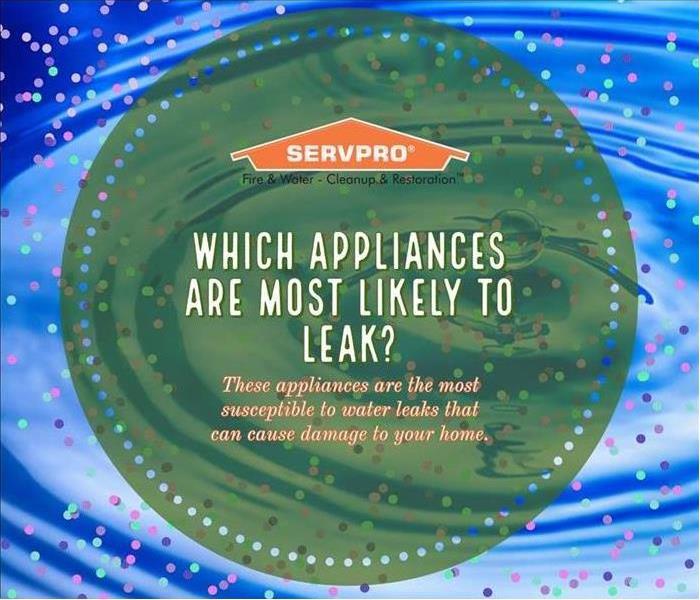 Watch your appliances for leaks
Watch your appliances for leaks
Although any appliance that uses water is susceptible to a leak, here are the ones you need to be most aware of to prevent a wet disaster in our home.
Hot Water Heater
Most water heaters will last 10-15 years, but leaks can happen at any time. The seals going into the water heater can break down quickly because of the constant pressure from heating and cooling. With hot water heaters also being tucked away into closets, leaks can go unnoticed until they become a major problem.
Dishwasher
A dishwasher's water lines are typically make from a soft plastic that can easily fail, so checking for leaks under the dishwasher as part of your annual home maintenance is wise. If you notice dishes not being clean, strange noises, or your dishwasher just not working right, inspect for a leak.
Washing Machine
Washing machine hoses are some of the most common sources or leaks. Because they are notorious for this, it is recommended that they are inspected at least once a month by homeowners so you can be sure no issues have arisen. In addition to these regular checks, they should be fully replaced every five years in order to prevent hidden deterioration.
Air Conditioner
The drain in your HVAC unit is designed to keep condensation from pooling in and around the unit. But if this drain malfunctions, water damage can quickly be caused. Reference you manufacturer's manual to determine how often your unit should be inspected and serviced. Having a professional technician evaluate your machine is the best defense against HVAC-created water damage.
While not as likely to create as big of a mess, window air conditioners can also create leaks from condensation buildup, pump failures, and a number of parts issues. Most of the time these leaks can be cleaned up with towels and the unit repaired, but improper use over a period of time can create a leak and cause a mold problem as well.
Warning Signs of Mold in Your Home
8/26/2022 (Permalink)
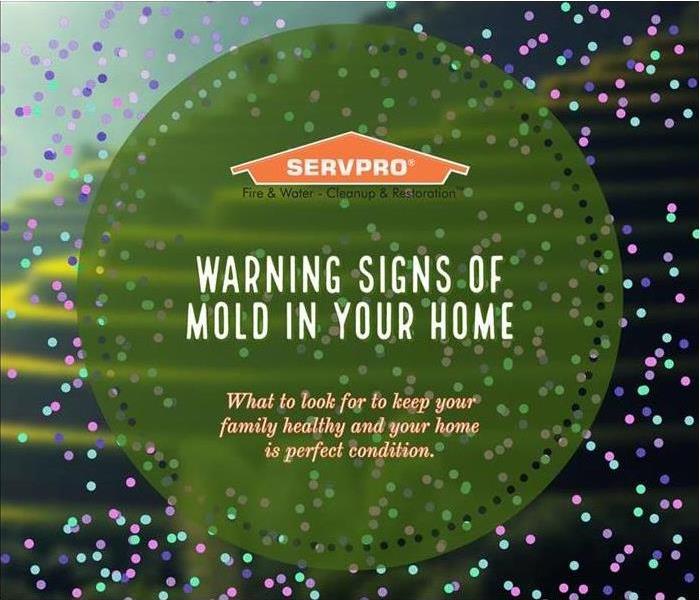 Watch out for these warning signs
Watch out for these warning signs
As summer weather conditions continue to heat up in our area, you begin to notice signs of mold in your home. Read below to get a step ahead of these signs and stop mold growth before it becomes a major and costly problem.
Smell
If you notice a musty odor, especially one coming from your basement or crawlspace, this is a very good indicator of mold. Even if you can't see any discoloration, the smell could be coming from behind the flooring or walls where you can see it. By the time you can smell it, steps should be taken to inspect for mold and then clean or remove any affected materials.
Leaks or Past Water Damage
If you have experienced recent or past water damage, of if you notice there is a current leak in your home, mold growth may have taken place. Mold grows in dark, moist environments and a leak can provide enough moisture for mold growth. Additionally, past floods can contribute to mold growth. To prevent water damage from turning into mold, act quickly to dry up any leaks or spills. If it is major damage, contact a professional remediation company, such as SERVPRO of Bismarck, to clean it up fast.
You'll Need to Add These 3 Things to Your Fall Chore To Do List
8/26/2022 (Permalink)
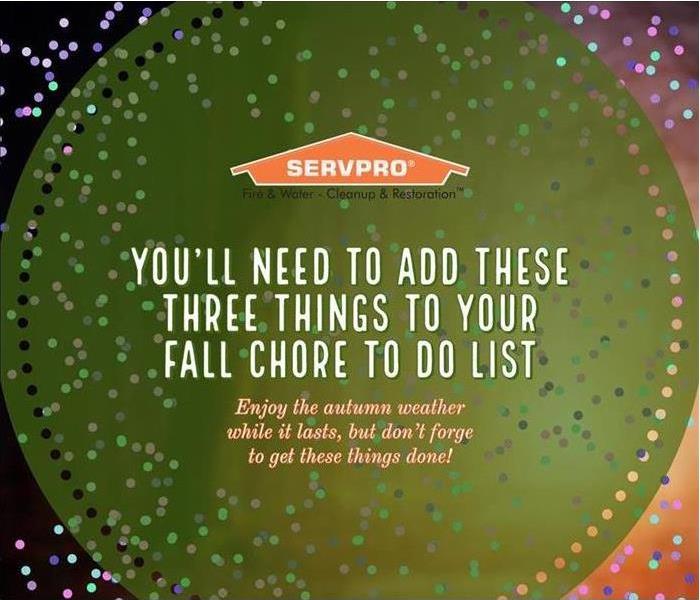 Fall is coming!
Fall is coming!
None of us North Dakotans want to think about the end of our warm weather and the bitter cold winter that is approaching. However, as we get into September and further into autumn weather, there are some things you will need to have on your to-do list this fall to prepare your home for winter.
Cleaning Gutters and Downspouts
This is a chore that should be done after the leaves around your home have already fallen. Clean gutters allow your home to drain rainwater properly during the winter. Proper drainage also helps prevent ice dams from forming on your roof, leading to leaks and water damage in your home.
Clean Fireplace and Replace Furnace Filter
These two moves will drastically improve the air quality in your home as well as reduce the risk of fire once the temperatures begin dropping outside and you need to keep your home warm on the inside.
Drain and Put Away Outside Hoses
During the summer, we use hoses on everything. From watering plants, to filling up a swimming pool, yet once the cold weather comes in, it's easy to forget and leave them outside. This a quick and easy step that can prevent water in the hose and pipe from freezing and causing damage in your home.
Although we hope to have a wonderful autumn this year, be sure to remember to get your chores done before the snow starts to come down.
Our 3 Steps for Removing Pet Odor from Carpets
8/26/2022 (Permalink)
 Get rid of smelly pet odors!
Get rid of smelly pet odors!
As a homeowner, property manager, or new tenant, one of the worst things you can find on your property is the smell of pets. Pet urine, and especially cat urine, is one of the most notorious smells of its terrible stench along with the difficulty to remove it. Here are the steps we take when trying to remove those unpleasant odors from your home.
Deep Carpet Cleaning with Deodorizer
If pet odor is in the carpet, the first thing that should be done is clean the carpets. Adding a deodorizer agent will help to break down the molecules that cause the smell. Using our powerful truck-mounted steam cleaners, we are able to remove dirt, hair, and stains to help eliminate the smell from the carpet.
Ozone Machines
Using an ozone machine, also known as an ionizer machine, we are able to release ozone molecules into the air which break down contaminants in the air such as odors. This process breaks down the actual molecules causing odor rather than trying to cover it up or remove the odor.
Carpet Replacement
If the above steps are done and the pet odor is still in the air, we look at carpet replacement at that point. We have and in-house team of remodel and reconstruction experts who can replace a small section or an entire room of carpet. Using lab analysis, we can match a carpet sample to the exact manufacturer, and have it replaced to get the exact look you need and enjoy.
Although nobody ever wants to find pet odors in their home, we Bismarck's local experts at odor removal and will help you to get your property smelling fresh again!
3 Tips for Fire Prevention
8/26/2022 (Permalink)
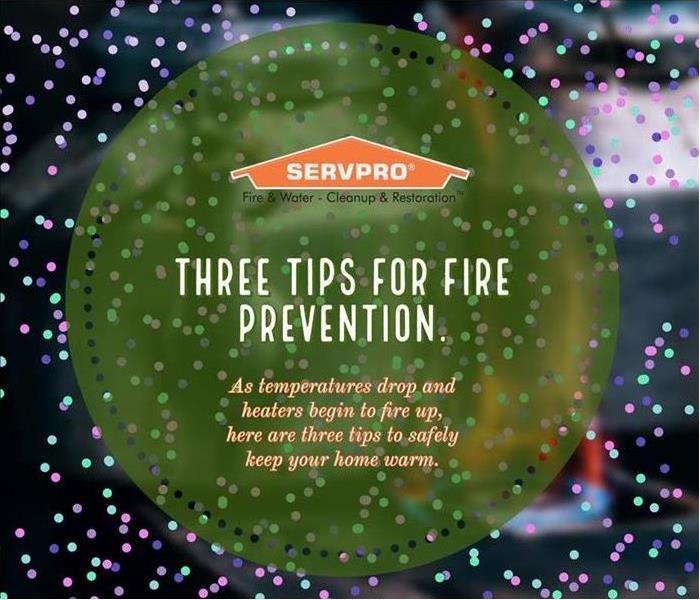 Read these tips to avoid an accidental fire
Read these tips to avoid an accidental fire
358,500 homes experience a structural fire each year (NFPA). This is a heartbreaking statistic so we wanted to share three quick tips you can use to prevent a fire in your home.
Leave Space Around Heat Sources
No matter how you heat your home, it is important to leave room around the source of heat for each room. Dry materials can combust without directly touching a hot object. Items like clothes, papers, furniture, and pet/baby toys should be kept away from hot air that could heat them to the point of combustion.
Don't Sleep with Space Heaters On
Leaving a space heater on at night is a recipe for disaster. Anything from a wiring failure, manufacturer defect, or a pet knocking it over, could be the cause of a fire. While we all love to sleep in a warm, cozy room, running a space heater at night is a bad option. Instead, run it a few hours before you go to sleep to heat up the air.
Clean Cooking Surfaces and Range Hoods
Grease builds up quickly in the kitchen, especially those that use a lot of oils or butters to cook. Make sure to clean off your stovetop and oven to prevent buildup of grease on these surfaces. Additionally, clean the range hood which is a forgotten surface that builds up grease and dirt quickly.
As we approach colder weather and we start firing up the furnace to heat our homes, remember these tips for protecting your home.
What to Do if You Discover Water Damage in Your Home
8/26/2022 (Permalink)
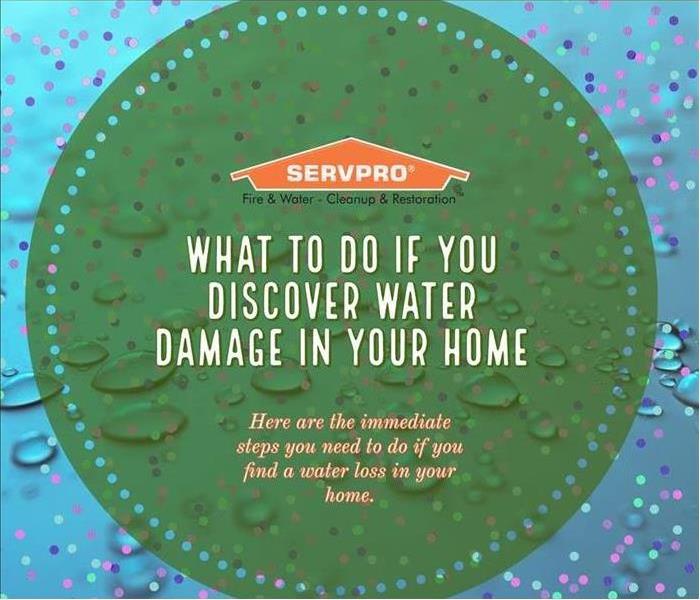 Here is what to do if your basement floods, roof leaks, or sewer backs up!
Here is what to do if your basement floods, roof leaks, or sewer backs up!
Water damage comes in many forms. When you first discover it you can be in a panic and not know what to do. Here are the first steps you should take if you discover a large water damage incident in your home.
Turn Off the Water
It doesn't matter how quickly you can clean up the existing water if you do not stop more from coming in. Find and close your home's main water valve. Also turn off any circuit breakers to that area to prevent an electrical shock.
Call Your Insurance Provider
Get in touch with your home insurance company and let them know you have had a water damage incident. They will open a claim and will schedule an adjuster to come assess the damage.
Call SERVPRO of Bismarck
After you get the claim number from insurance, contact us so we can immediately send a technician to begin the mitigation process. With water damage, the sooner the excess water is removed and drying, the cheaper and quicker the process will be. Once you give us your insurance information, we can work with that provider to begin work.
Clean Out Any Items That Could be Affected
If water is in an area, it will continue to spread out and absorb into materials. Place furniture on wood blocks and remove boxes, clothes, or other items in the immediate area that could be damaged by water. Preventing further damage will save everyone time and money. If the water is contaminated by either sewer or wastewater, anything that is touches will need to be cleaned or replaced.
Discovering a water loss in your home can be scary. Just follow these steps and you will be on your way to making it "Like it never even happened".
What Needs Replacing After Water Damage?
8/26/2022 (Permalink)
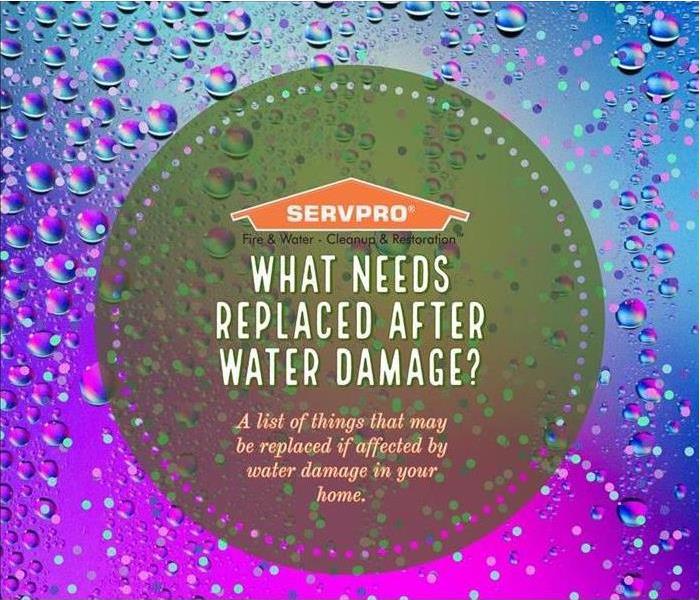 More things might need replacing than you think!
More things might need replacing than you think!
Water damage can happen unexpectedly. Anything from a dishwasher hose break, a sump pump failing, or a toilet backing up can lead to hundreds or thousands of dollars in damage. This cost is what it takes to remove the water, dry out the affected area, remediate any potential mold growth, remove unsalvageable materials, and replace those materials. This is why a full coverage insurance policy is a must-have for homeowners, covering the cost for the work to get your property back to a preloss condition. Here are some items that you might need to replace if you have a water loss in your home.
An important note is that anything touched or effected by dirty water such as sewer or that contaminated by waste, needs to be replaced or thoroughly cleaned and disinfected. Other items that may need replacing are:
- Water can seep into the wall and soak up into the insulation behind it. To prevent further damage, we create 3 foot flood cuts on any affected walls. This means removing the bottom 3 feet of wall and removing wet materials.
- Like walls, removing and replacing flooring affected by water damage is necessary, (if the floor can't be dried out properly).
- Children's toys
- Dog toys
- Furniture
- Trim/baseboard
- Cabinets
While we never think of water damage happening in our home, it is important to be prepared for it. Check your insurance policy, maintain your home, and if you ever have water damage in your home, call SERVPRO of Bismarck as soon as possible to get the water damaged cleaned up quick!
Tips for Cooking with Oil
8/26/2022 (Permalink)
 Be safe around hot oil!
Be safe around hot oil!
The number one cause of house fires is from cooking. The heat we use to cook our food can be dangerous when we are careless or leave a hot surface unattended. Cooking with oil is especially dangerous due to the volatility of hot oil. Below is a list of best practices for cooking with oil to make sure you and your home stay safe.
Never Leave a Hot Frying Pan Unattended
A fire can quickly ignite and become uncontrollable within seconds. Leaving the kitchen for even a short time can be disastrous for your home.
Smoking Oil is Dangerous
Is you are heating up oil and it begins to smoke, this is a warning sign. Immediately turn off the stovetop and wait at least 15 minutes for the surface to cool. If possible, safely move pan from burner and set on a unheated burner or other surface.
Keep a Lid Nearby
If a fire does happen, place the lid over the pan to suppress the fire. Do not throw water onto the hot oil as the water will instantly boil and set off a burst of hot oil and water that can only spread the fire.
Cooking with oil is a quick way to make all of your favorite foods and recipes. Using caution, you can have a wonderful meal with no worries. Be sure to exercise safety when cooking at all times and hopefully you will never have to worry about cleaning up a fire in your home.
How to Safely Set Up a Christmas Tree
8/26/2022 (Permalink)
 Have a safe holiday season!
Have a safe holiday season!
Every year, U.S. fire departments respond to ≈160 fires that started from a Christmas tree. These fires cause injuries and death along with millions of dollars in property damage. To keep your family and home safe this holiday season, follow these tips below.
Choosing a Tree
- If choosing a real tree, use one with fresh, green needles that do not fall off with normal movement
- Remember to water your tree daily
- If using an older tree, make sure the pieces aren't broken and are stable enough not to fall over
Lighting the Tree
- Make sure to use indoor lights and not outdoor lights
- Never leave lights on at night or while away from home
- Do not use candles as lights or have near the tree. Contact with a flame is not needed for ignition
- Replace any broken or frayed lines that are on your lights
Placing the Tree
- Do not place your tree within 3 feet of any heat sources such as fireplaces, radiators, candles, heat vents or powerful lights
- Before placing the tree in the stand, cut 2 inches from the base of the trunk
- Make sure the tree is not blocking an exit and isn't in a path where people or pets could trip over it
Christmas is a wonderful time to celebrate with friends and family. Be sure to use caution and safety and have a great holiday season!
The Leader in Advanced Restoration Technology
8/26/2022 (Permalink)
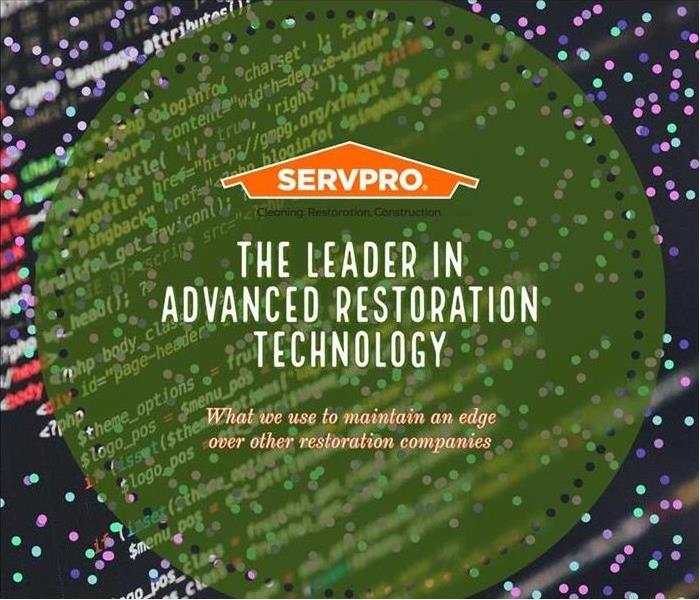 We are on top of the game!
We are on top of the game!
As a leader in property restoration, SERVPRO of Bismarck uses the newest tools and technology to the job done right. From advanced drying equipment to latest restoration software programs. We keep:
Mold Testing Technology
When faced with mold, we have a testing system to guarantee that mold is in the area. With lab analysis, we can know within 24-36 hours whether or not there is mold in an area that needs remediation.
Testing for mold allows us to save homeowners and property managers money and time. A post-test also allows us to certify that our remediation efforts were successful and removed the mold from the property.
DryBook™ Job Tracking Software
Using our trademarked restoration software, we can log jog details, know how much equipment to use, and have customers fill our forms electronically on site. Electronic documentation also allows easier communication with insurance representatives and our office staff.
Matterport™ 3D Model Camera
Our Matterport™ 3D Model Camera is unlike anything other restoration companies have! Using this, we can map the job site and create virtual 3D walkthroughs of the property. This helps with creating estimates, communicating with insurance representatives and documenting the progress of the job from start to finish!
We strive to be the leader in cleaning and restoration. Finding and using the latest in restoration helps us to make every disaster "Like it never even happened."
What to Do if a Fire Starts in the Kitchen
8/25/2022 (Permalink)
A scenario that everyone fears happening - you're cooking your meal in the kitchen when suddenly there is a big burst of energy and flames erupt! What happens next could mean the difference between your safety, your family, and your home. Here are some tips on what to do if there is ever a fire in your kitchen:
- Grease fires cannot be put out with water. If you are using cooking oil or cooking foods that give off large amounts of grease and they ignite into a fire, throwing water on that fire will only cause it to vaporize into steam which can cause burns to yourself as well as increase the flare of the fire. Instead, try to cover the flame with a lid or dish that will cut off oxygen supply and eventually put out the flame. If you can safely turn off the heat source, that will help as well.
- If there is a fire in your oven or microwave, do not open the door. Instead, turn off the heat source and let the flame die out on its own. Opening the door can allow fresh oxygen to reignite the flame which would otherwise die out.
- Do not try to put the fire out by swatting at it with a towel or cloth. This will only fan it and increase the possibility of it spreading onto that towel or cloth. Instead, try smothering it with a large, wet towel. Quickly soak the towel and cover the whole pan with to try to put out the flames. If it is already too big of a fire, this will not work.
- Make sure to have a fire extinguisher in your kitchen that is easily accessible. This is your best bet for putting out the fire before it causes any further damage as well as the safest option for you.
The one thing you should remember about kitchen fires is that you should never try to be a hero. You will know almost immediately whether you can put the fire out and should call 911 if you have any doubts about if you will be successful. Even a small fire can spread quickly and waiting for it to get out of control can be the difference between having a smoky kitchen and suffering from catastrophic fire damage. If you can not contain the fire immediately, call 911 for help.
Certified: SERVPRO Clean
8/25/2022 (Permalink)
Let Us Help You Get Back to Business
As our communities continue to re-open, we're all moving back to a new kind of normal. The expectation of visitors, customers, and employees who come into our establishments have evolved, and staying safe and well is a top concern. The global Covid-19 pandemic has changed what it means to be clean, even here in North Dakota, and we've developed a program to help your business meet the new higher standard of clean that is now expected.
We are proud to launch Certified: SERVPRO Cleaned, a cleaning and disinfecting program that SERVPRO offers to commercial locations to address the current Covid-19 pandemic. This is a level of clean that goes way beyond janitorial or carpet cleaning. This is proactive viral pathogen cleaning. When businesses choose SERVPRO, their customers, employees, and community can rest assured that they've selected a "higher standard of clean" - Certified: SERVPRO Cleaned.
Extensive Training and Specialized Products
As the #1 choice in cleanup and restoration*, we stand on more than 50 years of experience and expertise to help your business become Certified: SERVPRO Cleaned. Beyond fire and water, SERVPRO professionals are trained and experienced in biohazard decontamination and chemical spills - always adhering to the cleaning and decontamination standards set by the Center for Disease Control and Prevention and local authorities.
From formulating and creating our proprietary cleaning products, like SERVPROXIDE, at our headquarters in Gallatin, TN, to taking the upmost care while disinfecting our local businesses in Bismarck and the surrounding areas, we will ensure you and your business are set up to inspire consumer confidence as the economy continues to re-open.
3 C's - Consult, Clean, and Certify
When the stakes are this high, you want a partner who has developed an industry leading, proprietary training program, cleaning solutions, and remediation process over the last few decades. We've cleaned up some of the most challenging biohazards imaginable. Certified: SERVPRO Cleaned reflects our unique experiences and capabilities. The program is grounded with our unique 3 C's: Consult, Clean and Certify.
- Consult - Every business is different, which is why you'll be assigned a Cleaning Protocol Consultant who understands your business and will create a cleaning program to meet your specific needs. This program will be developed based on your business type, size of space, amount of high frequency touchpoints, foot traffic, and congestion points.
- Clean - Based on your specific business needs, your location will undergo a thorough deep clean using exclusive cleaning products according to protocols set forth by the CDC. Our employees have years of experience, and we will go beyond the scope of work that regular janitorial staff perform. Cleanup procedures generally include cleaning of porous and non-porous surfaces, cleaning and disinfection of equipment, tools, and/or supplies used for the cleanup process and disposal of hazardous materials. In the event of a suspected or confirmed Covid-19 event, we will be there within 24 hours to ensure you get back to business as quickly as possible.
- Certify - Once your business location has been Certified: SERVPRO Cleaned, you will gain access to proprietary signage, digital emblems, and other collateral that communicates that you've selected a higher standard of clean available to help protect your employees and customers. And because we add the day, month, and year to that proprietary stamp of clean, your guests will know that not only did you choose Certified: SERVPRO Cleaned, but that your location is being cleaned regularly at this standard.
Call today for a Certified: SERVPRO Cleaned consultation
We're here to help, 24 hours a day, 7 days a week
* #1 choice in cleanup and restoration based Commercial Attitude & Usage Tracking study. Polling 816 commercial business decision makers on first choice for future needs related to cleanup & restoration work. Study conducted by C&R Research: October 2019
Certified: SERVPRO Cleaned means professionally trained SERVPRO franchises perform the requested cleaning, sanitizing and disinfection services according to proprietary SERVPRO protocols and recognized industry and CDC standards with EPA approved cleaning products to deliver a SERVPRO certified cleaning experience. Each SERVPRO franchise is independently owned and operated.
The Concern with Hail Damage
8/25/2022 (Permalink)
Hail damage has increased over the past few years, with billions of dollars in repair costs every year across the US, hail is one of the most expensive repair costs overall. In 2017, there were 6,045 hailstorms recorded (NOAA) coming out to an average of over 16 storms a day. While some of the storms may have been mild, all it takes is one violent storm to cause damage to your entire home.
The worry with hail is that the impact will leave broken windows, damage your roof and chips in the siding. While most likely not deadly, these can be additional costs which you don't want to deal with. The worst fear with hail is that the damage will create miniscule cracks which will allow water to seep in and damage your ceiling. Unlike traditional water damage, which can usually be detected easily, you may never know about the leak coming from the damaged roof until it is too late.
What You Can Do
There are steps you can take to be best prepared for a violent hailstorm. Before the storm arrives, you can have your roofing updated to be impact resistant. Paying for upgrades will almost always be less expensive then waiting until after storms for repairs.
Keep supplies ready for a storm. Once a storm comes through, it may knock out power so having a generator as well as food and water will be important. In addition, have plywood or other materials for boarding up damaged windows until they can be replaced and repaired. If you don't have any, at SERVPRO of Bismarck, we respond to storm damage and board up windows of all sizes until they can be replaced.
Your insurance policy should cover all things involved with hail so that you don't need to worry about the cost of damage and sleep soundly knowing that you're covered.
Although there is nothing you can do to completely protect yourself from hail damage, you can take steps to reduce the impact and give yourself some peace of mind for when it happens. The best thing you can do is be prepared and be educated about what the impact of a hailstorm could be.
What is a Sump Pump?
8/25/2022 (Permalink)
 Your Home's Best Defense Against Water Damage!
Your Home's Best Defense Against Water Damage!
You will almost never think about your sump pump, unless it's broken, and that is the way it should be. A sump pump has one purpose and that is to make sure you never think about it because it is doing its job perfectly of keeping your home safe and dry. But what, exactly, is a sump pump?
Below your basement is a catch basin that is designed to accumulate water from around your home so that it does not seep inside the foundation, which is known as a sump. When the water accumulation begins to fill the sump, a pump is used to move the water out of the basin and into a storm drain. This pump, the sump pump, keeps water out of your basement, leaving it dry.
There are different types of sump pumps. Some are automatic, while others need to be manually operated. There are also submersible sump pumps, pedestal, battery operated, water-powered, and a variety of others. The type of sump pump you have depends on your budget, preferences, and the environment around your home.
A sump pump is your home's best defense against water damage. While it can't prevent damage from broken pipes, leaks in the roof, or appliance malfunctions, a sump pump can prevent water around your home from causing any problems. Without a sump pump, your basement could have a constant influx of moisture which would cause weak floors and walls, odors and mold growth. A worst case scenario would be completely flooded basement because there was nothing pumping the water out.
Keeping your sump pump in working condition is crucial, having a broken sump pump is better than not having one at all. Typically, a sump pump is good for 5-10 years and will either need replacing or repairs afterwards. Hopefully, once you set it in place, you won't have to think about until after those 5-10 years, which is when it is time for replacement.
How do you know when to replace a sump pump? If it is making unusually loud noises, this could be due to several factors, including debris jams, worn out parts, or constant use. If you are concerned about your sump pumps condition, test it by dumping water around the pump and see if it starts automatically and drains the water quickly. If it appears to be operating incorrectly, contact a service provider to replace it. You don't want to wait to do this as you never know when a heavy rainfall could occur.
Preparing for a Tornado in North Dakota
8/25/2022 (Permalink)
North Dakota Tornado Preparedness
North Dakota is known for its tornadoes. With an average of over 20 per year, it is a common occurrence within our state. Although most of these cause little to no damage and are hardly even noticed, there are some that cause massive devastation. In 1957, the tornado in Fargo resulted in $26 million in property damage ($236 million in 2020 USD) along with 12 fatalities. While the 1957 tornado was by far the worst to hit the state, smaller ones can cause damage to your home, vehicle, and business if you are not prepared.
The CDC recommends these 3 tips for tornado preparedness:
- Be ready
- Be aware of weather conditions
- Know where to shelter
Be Ready
This means having an emergency kit ready that has batteries, first-aid supplies, flashlights, food/water, and a battery-operated TV or radio. Have a plan for you and your family which you can go over and practice to make sure that it can be put into action immediately.
Be Aware of Weather Conditions
Paying attention to weather reports will give you an advanced warning of incoming storms. On your smartphone, you can have notifications turned on that alert you of bad weather. Additionally, you can watch for these weather patterns that indicate a tornado may be coming:
- A dark or green colored sky
- A large, dark, low-laying cloud
- Large hail
- A loud roar that sounds like a freight train
Know Where to Shelter
As a storm hits, you need to be able to take shelter to keep yourself safe. Best practices include:
- Go to the basement or an inside room with no windows on the lowest floor (bathroom, closet, center hallway).
- Avoid windows.
- For added protection, get underneath something sturdy (a heavy table or workbench). Cover your body with a blanket, sleeping bag or mattress. Protect your head with anything available.
- Do not stay in a mobile home.
- If you are outside or in a car, find a stable building to get behind and move only when it is safe.
Odd Places to Find Mold Growth in Your Home
8/25/2022 (Permalink)
Mold can be found in many unusual spots in your home. If left to grow, mold can become a dangerous problem for your home's value, your health, and as a cosmetic eye sore. Here are some places to check and clean to avoid these problems.
Your Toothbrush Holder
While your toothbrush gets replaced every few months (hopefully), your toothbrush holder is an ideal location for mold growth. The moist environment of the bathroom combined with a wide array of germs from your mouth create the perfect location for mold growth. A few times a year, you should clean and disinfect your entire toothbrush holder.
Your Appliances
Specifically, your dishwasher and clothes washer are susceptible to mold growth. Check behind and underneath them to see if the darkness and moisture has cause mold growth. You can then clean the area before it grows on the walls and into the flooring, which is more costly to clean and repair. Also, check INSIDE your appliances. Look under coverings and around rubber moisture seals to expose mold which has developed inside the machine where the cleaning process does not reach.
Potted Plants
If you overwater your plants, there is a tendency for mold growth underneath where the sunlight does not reach. While this actually may be good for your plant, it is not worth the risk. Be careful not to overdo the watering and if you notice mold, try repotting the plants and put them in direct sunlight for a few days.
Outdoor Rugs and Floor Mats
Floor mats invite mold buildup underneath as the organic material from the rug, when wet, creates a dark, moist environment with enough air flow to sustain mold growth but not enough to dry it out. By regularly cleaning your rugs, or flipping them over, and leaving them in the sun for a day, you can prevent mold buildup which can spread throughout your entryways, steps, and porches.
How to be Safe in a Lightning Storm
8/25/2022 (Permalink)
Hundreds of people are struck by lightning each year. So, while you are unlikely to be struck, there is still a significant threat which should not be ignored. Even though there is no way to be 100% safe from lightning, even if you are indoors, there are steps you can take that will decrease your chance of injury.
Being indoors does not mean you fully protected. There is a myth that you are completely safe from lightning if you are indoors. While being inside is the best way to remain safe during a lightning storm, you should follow these steps to make sure you are as safe as possible.
- Stay off corded phones, computers and other electrical equipment that puts you in direct contact with electricity.
- Avoid plumbing, including sinks, bathtubs and faucets.
- Stay away from windows and doors and stay off porches.
- Do not lie on concrete floors and do not lean on concrete walls.
- Stay away from windows which can have projectiles flung through them by the storm.
Being outside is the most dangerous place to be during a lightning storm. If you are outside and see a storm coming towards you, head for the nearest building and shelter inside. Stay inside until the storm passes or it dies down enough to get somewhere safer. While there are suggested tips for what to do during a lightning storm. Your safest option is always to keep moving towards a stable building. Never stay under a tree or park structure. A good measure for if a building is safe is if it has both electricity and plumbing that will protect from electric strikes. If you are unable to get inside a substantial building, get inside a vehicle and park away from tall pointed structures such as trees or telephone poles.
Why We Test for Mold
8/25/2022 (Permalink)
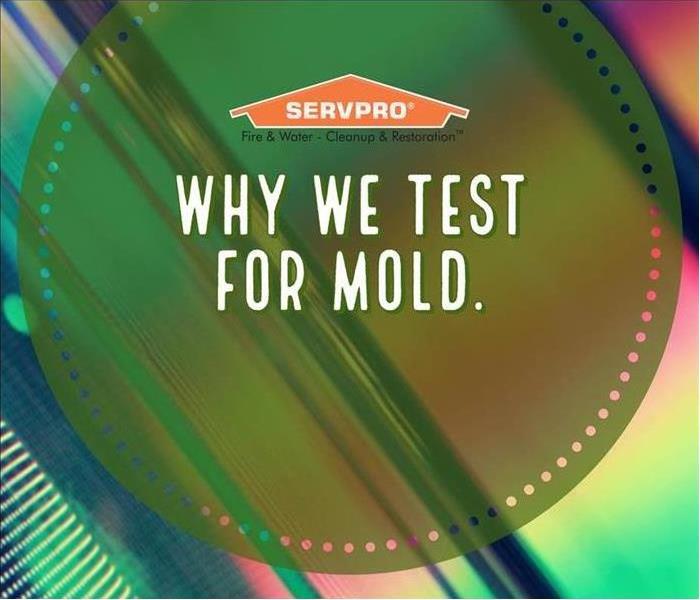 Let us test for mold!
Let us test for mold!
Mold is one of the most challenging projects we encounter. This is due to the location of the mold being in dark, hard to reach areas such as basements, or behind drywall and flooring. That means that our remediation efforts are hard to judge just by sight and the only way to truly know how much of an impact was made is to test the air quality.
Mold releases spores into the air which the accumulate on organic, wet material to grow the mold that we see. While these spores are everywhere and basically harmless, mold infected areas such as basements become hot spots for spores as they stay in the stagnant air flow of the basement and multiply into dangerous levels. If unchecked, these hot spots can lead to extreme mold growth which damages surrounding organic material such as important beams and frames, along with potential health risks.
To make sure we remove all spores and the ensuing growth, we conduct a series of tests in and out of the area. Before we begin work, we test both the suspected work area along with an area we know is not impacted to develop a control. Within 24 hours, we have the results from the test and know what kind of mold is growing in the area and the associated health effects that come with that type of mold.
Once we have finished our mold remediation, which involves removing and replacing impacted materials, applying synthetic products to prevent future growth, and using filtered vacuums to remove airborne spores, we then test the area afterwards to ensure all mold material was removed.
We are the only mold remediation company in the Bismarck area that tests for mold to confirm removal.
By testing, we remove any doubt as to the effectiveness of our efforts, and make sure the customer is not wasting money. With most types of cleaning, you can see whether or not you were successful. But with mold, there is no way to be sure without testing, which is why we encourage it whenever we are called for mold remediation.
Secure Your Home Before Your Summer Vacation
8/25/2022 (Permalink)
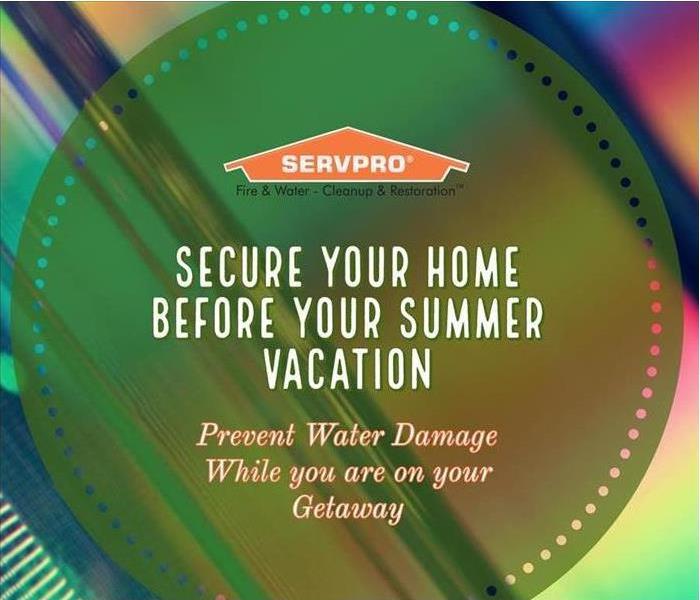 Keep your home safe this summer!
Keep your home safe this summer!
As we make our way through the summer months, you may be going on a trip or two. If so, here are some simple ways to make sure you come back to your home safe and sound, and not a watery nightmare.
Do an Inspection
As you're packing the car and getting ready to head out, do a quick inspection of your home to ensure you are ready to leave. Turn off the water main, and drain the existing water from the sinks, toilets and outdoor spigots. Once the water main is switched off, turn on faucets, spigots and flush toilets under water no longer flows out.
Other places to inspect:
- Pipes under every sink
- Water heater
- Seals around windows (in case it rains)
- Appliance hoses: washing machine, dishwasher, and ice maker
- Sump pump - dump a bucket of water into the sump pump to make sure it's working. Make sure to listen to its motor running as well.
- Toilet tanks - look for cracks that may worsen and leak while you're gone
Have Someone Check Your Home
Give a set of keys to a trusted family member, friend, or neighbor and have them check on your home periodically while you're gone. The amount of times they should check in depends on the length of your trip, but should at least be twice a week. Once water damage occurs, letting it stagnate for days at a time can multiply the cleanup cost tremendously. Show your house sitter all bathrooms, where the water main is, and other areas that are at risk of water damage. Leaving a check list for them will make sure they don't miss any subtle leaks or moisture.
Leave heating and cooling running as normal. These allow air flow through your home and prevent humidity from building up. They also will keep pipes from freezing if there is a sudden temperature drop one night, which is more of risk during the fall and winter months than in summer.
Enjoy Your Trip!
If you do a thorough inspection, take proactive safety measures and leave someone to look after your home, then you have done more than enough to ensure you won't suffer from water damage. Although anything is possible, and even the most cautious plan can still not prevent water damage, you shouldn't worry about the safety of your home while on vacation. Take steps to prepare and enjoy your time away!
How to Properly Test Your Smoke Alarm
8/25/2022 (Permalink)
 Don't forget about the smoke alarm!
Don't forget about the smoke alarm!
While it is a task that is quite boring, monotonous and may seem like a waste of time, testing your smoke alarm can literally be a life or death decision. So while yes, it is boring, this simple task can save the lives of you, your family, your pets, and your home. Here is the proper way to test your smoke alarm to keep everything you love safe.
Make Sure You Can Hear the Alarm from Everywhere in Your Home
Have someone stand in the room farthest away from the alarm with the door closed to make sure the sound is audible. If they can hear it clearly, you are good to go. If not, you can try replacing the batteries to improve hearing or you can buy another detector to place in a better spot.
To test the alarm, it's as simple as holding the test button and waiting for that piercing noise to ring out, confirming the batteries and sound are working correctly. However, this does not test whether or not the alarm is detecting smoke properly.
Testing smoke alarms using smoke should be done a few times a year, safely, in order to ensure proper functioning of the detector. After warning the members of the house that you are testing the alarm, strike and match and then blow it out, holding the match about a foot away from the detector. The smoke given off should be enough to trigger the alarm. If not, repeat a few times to see if you're able to set it off. If there is still no response from the alarm, replace the batteries and try again. Remember, it may take a few minutes before the alarm will sound.
Safely testing your smoke alarms is a mundane task. But as a homeowner, it is your responsibility to make sure your home is safe along with everyone in it.
Why Commercial Buildings Should Use Professional Cleaners to Battle COVID-19
8/25/2022 (Permalink)
 Fight COVID-19 with SERVPRO
Fight COVID-19 with SERVPRO
As we continue to battle through the Covid-19 pandemic, commercial buildings have been doing a great job of continuing to implement different measures for keeping the people in those facilities safe. Here are the reasons why a commercial building may consider, or need, to bring in a professional cleaning staff.
Having a Emergency Response Plan
As Covid-19 continues to spread throughout our community, more people will be exposed and test positive for the illness. What will your workplace do when that happens? If there is an outbreak in your workplace, a response needs to be in place so:
- Employees can be safe
- Work can resume without the fear of infection from the work environment
A proactive plan should be developed that includes preventative measures to reduce potential exposure and also reactive measures for when exposure happens when a positive testing co-worker enters the workspace. This second situation, one where a person potentially left the virus in the workplace, is where a professional cleaning staff should be considered.
While normal custodial staff are equipped to handle regular cleaning operations, Covid-19 is different. This highly infectious illness could be transmitted to a unprepared custodial staff if they are not trained in wearing personal protective equipment (PPE). If they are exposed, it opens a legal gray area in which they can claim they were knowingly exposed to biological contamination without the right equipment.
At SERVPRO of Bismarck, we equip all our technicians with the right PPE, which includes gloves, respirators, and full suits for protection. Additionally, we have high-grade that have been recommended for CDC use against Covid-19. This, combined with full coverage insurance for our technicians, allows us to confidently send them into a biologically contaminated space.
Give us a call today to talk about setting up a Covid-19 response plan. This will allow you to have a response plan to place in battle the spread of Covid-19 if it should enter your workplace.
What to Do When You Find Mold in Your Home
8/25/2022 (Permalink)
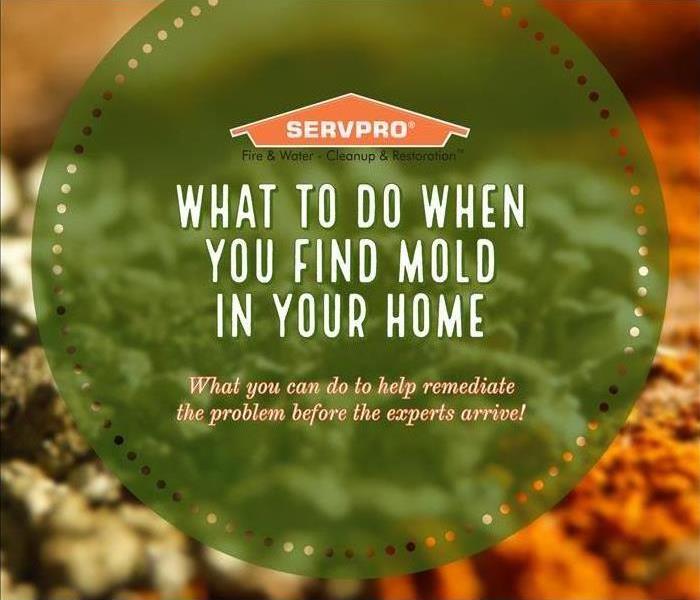 Call SERVPRO of Bismarck to help with your mold issue!
Call SERVPRO of Bismarck to help with your mold issue!
Discovering mold in your home can be a frustrating event. Not knowing how bad the problem is, how to remove it, the cost of a professional, and whether or not your home is safe are just some of thoughts you'll have. To help relieve some of these worries, here are some tips to help manage your mold problem.
The first step is to call the experts at SERVPRO of Bismarck. We will immediately respond to your call and have staff on site to provide help and advice. Every discovery of growth is different and having experts take a look at it is important in deciding what to do next.
Until we are able to get staff on site, here are some tips on what you can do.
Try and Contain the Area
Seal of the room the growth is in. Air movement will spread the spores around and can lead to further growth throughout your home. Staying out of it until technicians can determine the extent of the problem is a good way to keep you and your family safe.
Stop the Source
Mold growth is accompanied by moisture from a leak or other water source. See if you can stop the leak or remove the source as this will help reduce further mold growth. If this area is wet and needs to be dried, do not turn on fans as that will spread mold growth further around the room and house. Call SERVPRO and we can remedy both the water damage and mold growth.
Contact Your Agent
Contact your insurance agent and see if your home has a mold policy. This will go a long way towards saving you money on the remediation. If you don't have a policy, call your agent and talk to them about adding it to your existing coverage.
The best tip on how to handle the discovery of mold in your home is to remain calm and let the trusted experts at SERVPRO of Bismarck take care of you and your home, providing you with all the information you need to remediate the problem.
The Danger of Smoking to Your Home
8/25/2022 (Permalink)
 Don't smoke in your home!
Don't smoke in your home!
For years, smoking has been known to have negative consequences to your health, but what about the health of your home? Although smoking inside in public areas has been outlawed for some years, smoking inside is still common in many households across the U.S. Besides the health consequences for smoking, your home can also suffer damages as well.
Fire Danger
Smoking is the leading cause of death in home fires, with an average of 590 deaths annually and 1,130 injuries. Fires caused by smoking materials happen mostly in bedrooms (34%) and living rooms (43%), are areas where flammable materials such as blankets, carpets, and couch fibers are liable to catch fire if they are exposed to a flame from a cigarette.
Smoking is generally viewed as only harmful to oneself, or through secondhand smoke. However, if a fire breaks out from smoking, this damages the home and endangers the lives of everyone who lives there.
Resale Value
When trying to resell a home, one that has been occupied by a smoker can be tough to sell. The smell from cigarettes is a tough one to remove and simply cleaning the carpet is not always the solution. The smell of smoke can get trapped in cupboards, vents, and even along the ceiling. All of this combines to reduce the home value by almost 29%. This reduced value is sure to keep rising in severity as smoking becomes less common is society.
How to Clean
Smoke is one of the most challenging smell to get out of your home. Anyone who has burnt their dinner knows the smell can linger for hours. Years of smoking inside is even harder to restore a fresh smell. When dealing with smoke, simply spraying an air freshener or cleaning the carpet will likely not do anything to help.
Cleaning the walls and ceilings with a cleaning solution is a great start, followed by a deep cleaning of the carpets and floors. Oftentimes you may need to professionally clean your air ducts. The smoke smell can get stuck in your ducts, furnace, and air conditioning units, which will need to be fully removed to keep the smell from circulating throughout your home.
NFPA (Jan. 2019) Home Fires Started by Smoking. NFPA.com. Marty Ahrens.
Realtor Magazine. (July, 2018) How Much Cigarette Smoke Decreases Resale Value.
5 Steps for Preparing for a Big Storm
8/25/2022 (Permalink)
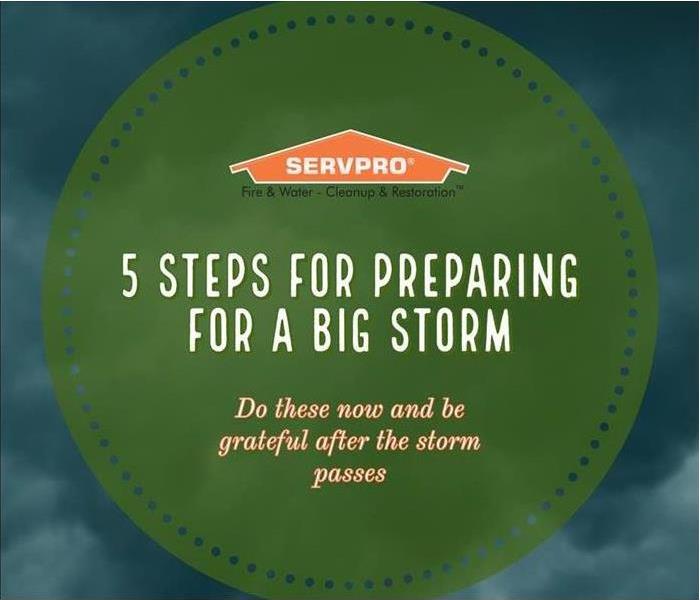 Follow these tips!
Follow these tips!
Storms can be dangerous weather events that leave destruction to your property as well as cause injuries and sometimes even death. Below is a checklist to make sure your that your home, family, and you can stay safe.
Prepare a Storm Shelter
Include essential supplies such as food, water, a first-aid kit, flashlights and batteries to last a few days in case of a severe storm or tornado.
Clear Branches and Dead Trees Around Your Home
The high-speed winds of storms can send dead branches or even trees crashing through your windows, siding and roof. Clearing these objects away from your house is an easy way to make sure they don't cause any damage.
Secure Outside Objects
The benefits of technology is having weather apps and stations that give us warnings before storms arrive. If a bad one is coming up, move large, outdoor objects inside to prevent damage to your house and those objects.
Document Your Valuable Items
Take pictures of valuable items that you can use to show insurance later. If they are damaged or lost in the storm, you have better luck with your claim if you have documentation. Include date of purchase and cost if you can. Bonus points for saving receipts!
Protect Your Pets!
When preparing for storms, oftentimes are forgotten about. Make sure to have a plan in place for your pets, whether that is in the storm shelter or if that means having them in a separate, safe location for when the storm hits.
Why Every Business Needs an Emergency Ready Profile
8/25/2022 (Permalink)
 Let SERVPRO of Bismarck handle your emergency!
Let SERVPRO of Bismarck handle your emergency!
Life throws challenges at us all the time, and as a business owner, you are constantly overcoming new challenges that arise throughout the day. Most of the time, these challenges don't slow down your everyday operations. But when disaster strikes, your entire company can be put on hold until it is resolved. A pipe busting, a break room fire, or flooded first floor can put businesses on hold for days, weeks, or even months, depending on the severity. Oftentimes a business can never recover after major building damage.
While you never know what disaster will strike, preparing for the worst can mitigate secondary damage and reduce the times the doors are closed. A SERVPRO Emergency Ready Profile (ERP) is a free assessment strategically designed to:
- Prevent damage from any disaster
- Establish clear communication and authorization for work to begin
- Help your business recover from any unexpected event
The ERP is not a full contingency plan, but rather an addition to your existing plan.
An ERP is a free assessment of your company's facilities and potential threats to their structural integrity. This profile is established by identifying high risk events that are specific to your facilities and addressing response options. An example would be a restaurant being at a high risk of fire damage, due to cooking and hazardous conditions in a kitchen. Therefore, planning where a fire would take place, identifying key access points such as switches to turn off gas and power lines and then having contact info for the local fire department, insurance agents, and SERVPRO of Bismarck to clean any damage that occurs.
As a restoration company, the sooner we receive a call, the sooner we can have staff on site. Establishing SERVPRO of Bismarck as your Priority Service Provider means we can respond to your emergency faster than normal and get your business open ahead of schedule.
3 Ways to Save Heat in Your Home this Winter
8/25/2022 (Permalink)
 Stay warm this winter!
Stay warm this winter!
As winter is fast approaching, all North Dakotans know that saving heat is important. Between saving money on energy bills and increased home comfort, these tips below are well worth the time and effort to get your home prepared for winter.
- Turn fans on: Circulate air throughout your home during the cold months. We tend to turn our fans off when it gets cold but turning them on can actually have benefits. As your furnace heats the air, that warm air eventually rises toward the ceiling and cools off or escapes through a window and imperfections in the roof. Turning fans on, and angling them towards the ceiling if possible, forces that trapped, warm air back down and heats your home.
- Use a humidifier: Moist air retains heat better than dry air, so running a humidifier can save money in heating costs while also adding many health benefits.
- Sealing leaks: The easiest and best way to retain heat in your home, and save energy costs, is through sealing leaks. Your home releases hot air through imperfections in building materials and construction design. Common areas to find leaks include around doors, windows, near the attic, where wires and cables enter your house, and around electrical outlets. Seal gaps around any pipes, wires, vents, or other openings with caulk or weather stripping. This costs as little as $5 and can save up to 10-20% of your heating bill.
Tips to Keep You and Your Home Safe this Christmas
8/25/2022 (Permalink)
 Happy Holidays!
Happy Holidays!
As we come towards the end of 2022, many of us are looking forward to Christmas. While some of us may still celebrate it a little differently, traditions will stay the same and it is important to stay safe while doing so. Here are some tips to keep you and your family safe.
Prepare Your Car for Winter Travel
As North Dakotans, we are used to bad winters, but it never hurts to be reminded of the basic winter travel necessities. Remember to keep plenty of gas in your vehicle and to keep your heat running in case of bad winter conditions leave you stranded on the side of the road. In your vehicle, you should also have:
- Extra blankets or coats
- Jumper cables
- Snow shovel
If traveling on Christmas:
- Make sure every person in the vehicle is properly buckled up no matter how long or short the distance traveled
- Watch for icy or dangerous conditions on the road
- Call ahead to tell someone you are on your way and when to expect arrival
For your home:
- If you plan on leaving for an extended period of time, make sure your home is heating properly and turn the water supply to your home to OFF
- Never leave open flames unattended. Whether it is a candle, fireplace, or something is cooking, don't leave those heat sources alone
- If using a live tree, cut off about 2 inches of the trunk to expose fresh wood for better water absorption. Remember to water it and remove it from your home when it is dried up
- Inspect lights for frayed or damaged wires
- Make plans for your pets to be taken care of
Christmas and the holiday season is a wonderful time of year. If you stay smart and safe, you can have an even better holiday season.
How to Reduce Health and Safety Hazards in Your Home
8/25/2022 (Permalink)
 photo via Burst Blog post contributed by Lisa Walker of neighborhoodsprout.org
photo via Burst Blog post contributed by Lisa Walker of neighborhoodsprout.org
Your home is a symbol of comfort and stability. We all want a cozy, safe place to live. Unfortunately, some common threats put your family at risk. For maximum comfort, remove any health or safety hazards. Here are some ways you can protect you can protect your home and your family.
Water Quality
Water quality is a common hazard that is often overlooked. However, neglecting to test or treat your water could potentially make you sick, so consider putting in a home testing kit. Home water tests kits are extremely affordable and can be found for as little as $10. In order to be considered safe, your water's arsenic level must be less than 10 parts per billion. It's vital to understand that you can't purify arsenic-contaminated water by boiling it. Because arsenic does not evaporate like water does, boiling the water increases the concentration of arsenic. Instead, stop drinking or cooking with your tap water until you can install a water treatment system.
Mold Prevention
In-home mold can cause health issues. To help eliminate mold from your home, it's often best to call an experienced professional who specializes in mold remediation. For instance, SERVPRO of Bismarck provides a mold remediation service that includes inspection and assessment, followed by mold containment, air filtration, mold mitigation and remediation, and cleaning. If you suspect your home has a mold issue, the mold remediation process can help.
Smoke Detectors
Fires are another home threat that could strike at any time. Place smoke detectors in each room and a fire extinguisher on each floor of your home. Replace the batteries annually, and be sure to test the smoke detector monthly.
Another way to keep your family safe in the event of a fire is to have a carefully planned escape route. The National Fire Protection Association provides online guides that will walk you through the steps for creating your own at-home fire escape plan. Because fires spread in as little as one to two minutes, it's vital to practice your escape plan as a family so that everyone knows what to do. If you don't have them already, it's also wise to purchase several fire extinguishers, one specifically for the kitchen, as well as a fire proof safe so documents and valuables are protected. Although you may not want to think about the possibility of a house fire happening to you, preparing in advance will help protect your family.
You deserve a safe, comfortable home. By taking the proper precautions, such as detecting and eliminating any potential safety hazards throughout your house, you can protect yourself and your loved ones. You'll sleep better at night with the peace of mind that comes from knowing your family, belongings, assets are safe and secure.
Contributed by Lisa Walker of neighborhoodsprout.org
What to Do if You Have Frozen Pipes
8/25/2022 (Permalink)
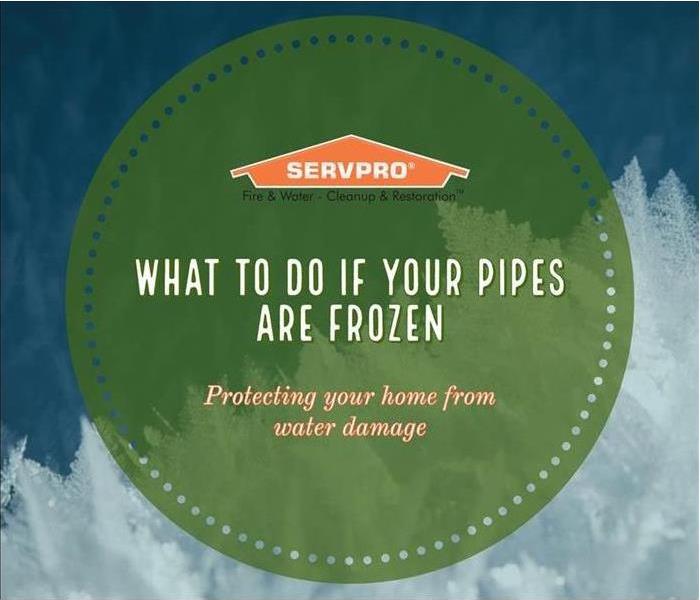 Watch out for frozen pipes this winter!
Watch out for frozen pipes this winter!
This is the time of year where harsh North Dakota winters pose the biggest threat of frozen pipes to your home. When water freezes in your home's pipes, the water molecules expand into an ice blockage preventing water from passing through. This creates a pressure buildup in the pipe which can lead to a burst a wet mess throughout your home or business. With North Dakota's long stretches in negative degree temperatures, your home's water pipes can quickly freeze if not taken care of. Here are some ways to know if your pipes are frozen and some remedies for how to fix them if you discover one is frozen.
Most of the time, a frozen pipe is not obvious. This can cause a problem as you will not even know it is frozen until it is too late. Signs of a frozen pipe include:
- No running water or even a trickle: In these cases, the pipe leading to the tap may be broken.
- Frosted over pipes: If you can see frost on a visible pipe, there's a good chance that it's frozen. Of course, this is more difficult to check on pipes that are not in visible areas.
- Odd smells: If a pipe is blocked because of ice, you or your tenants may notice an unpleasant smell coming from the tap or drains.
If you suspect a pipe is frozen, you should immediately shut off your main water line to prevent further water from flowing into the pipe. Next, you should attempt to slowly thaw out the pipe, if possible. DO NOT use open flames to thaw it out. Try using other heat sources such as a hairdryer or towels soaked in hot water or increasing the temperature of the room by bringing in warm air.
If you suspect your pipes are at risk of bursting, immediately call a plumber and have extra towels ready to soak up a spill. Additionally, find a water mitigation company (such as SERVPRO of Bismarck) and be ready to call them to cleanup any mess that may occur if the pipe bursts. The sooner a technician can arrive, the more damage can be prevented.
While frozen pipes can be a dangerous situation, if discovered soon enough, you can take steps to protect your home and avoid a costly cleanup charge.
SERVPRO Mission Statement
8/24/2022 (Permalink)
As new owners, Ryan Conklin and Lance Larson pride themselves on striving to be the best restoration company in North Dakota.
To develop a team of quality people to focus on excellent service, fairness and mutual respect.
With every fire, water damage or flood comes a wave of emotions. There is a certain amount of uncertainty and a loss of control. It can be your home, business or belongings that have become damaged. You don't just want them clean, you want your life back. You look to us, SERVPRO of Bismarck, to handle the situation.
We are a franchise system with over 45 years of leadership in the cleanup and restoration industry.
Our team takes to the streets, every hour of every day. Whether there's a house full of water, or an office filled with smoke, there is also a van full of equipment to clean it up. SERVPRO of Bismarck can make it "Like it never even happened".
Bleach Does Not Kill Mold
8/24/2022 (Permalink)
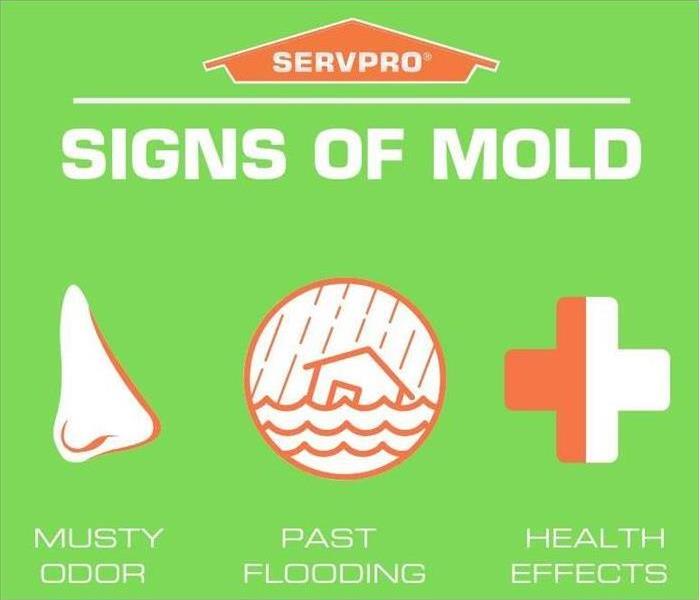 Watch out for these signs of mold!
Watch out for these signs of mold!
The Environmental Protection Agency (EPA) does not recommend using bleach to kill or remove mold. The idea that bleach can kill mold is a myth!
The chemical structure of bleach makes it unable to penetrate porous surfaces like drywall or wood, which means that mold membranes will simply retreat deeper into whatever surface they are on to avoid the chemical. Once first exposed to bleach, the mold recognizes it as a threat and can actually use it as a fungal food to grow more rapidly.
That's right - using bleach to kill mold can actually worsen the problem, and depending on the amount of bleach and concentration may even damage materials and structures.
Mold can grow anywhere inside of your home where moisture is present and there is a food source. Mold flourishes in moist environments, so from a small leak in the wall or improper attic ventilation can lead to mold growth. If you notice any signs of excess moisture such as water spots, floors buckling or bubbling, make sure to have a professional come inspect it.
If your basement has flooded or has ongoing excess moisture, make sure to have that evaluated as well. These preventative measures can help you save money prior to mold growth occurring.
If mold is discovered, do not try to clean it yourself. Sprays and chemicals can often worsen the issue. Remember, there is no one solution to kill mold. The cause must be treated, then the mold is to be professionally mitigated so all of it can be removed.
The Effects of a Sump Pump Failure on a Finished Basement
8/24/2022 (Permalink)
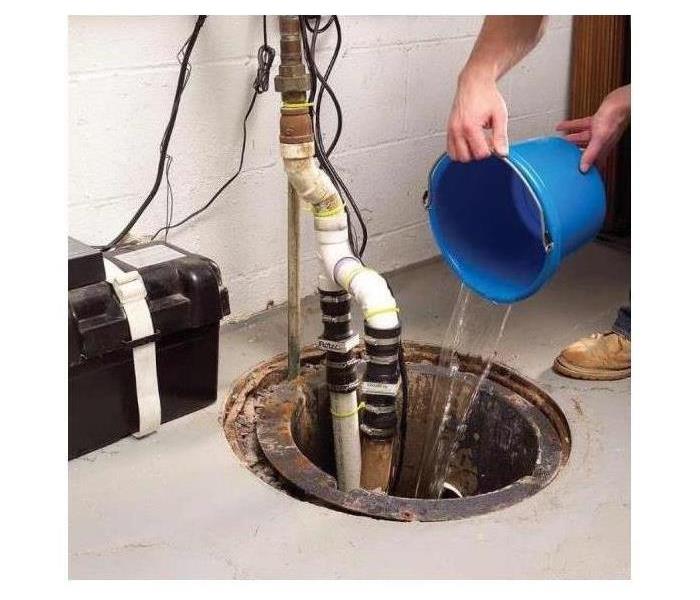 Check you sump pump regularly!
Check you sump pump regularly!
Sump pumps have an average lifespan of 3 to 5 years, which means of you own a home with a sump pump you can anticipate it failing at some point. Sump pumps are used to prevent water from outside seeping into your house, which is particularly common during heavy rainfall. It is important to ensure your sump pump is operating correctly.
To test your sump pump, fill a five-gallon bucket with water and pour it slowly around the sump pump. The pump should kick on once the water level reaches a predetermined level below the basement floor. If the pump doesn't turn on, it may be either clogged or damaged.
When sump pumps fail, water comes into your house that can be significantly contaminated. SERVPRO of Bismarck's technicians are trained to evaluate your home's building materials to determine which materials can be saved, and which must be removed.
Building materials that are not salvageable that are not removed can support microbial growth. Salvageable materials that are exposed to the water for too long can also be destroyed.
If you have any questions, call SERVPRO of Bismarck for your water emergency. With our trained professionals and specialized equipment, we will make it "Like it never even happened".
Tips for Finding a Contractor in Bismarck to Repair Storm Damage
8/24/2022 (Permalink)
Unfortunately, the increase in the number of storm- related claims may lead to an increase in the number of unscrupulous roofers and contractors who are willing to take advantage of homeowners. It is very important for you to be cautious when dealing with contractors who offer to repair your home.
Here are some tips:
- Only do business with licensed contractors with good references.
- Always request a written, detailed estimate.
- Never pay for any work up front, nor make any payments in cash.
- Never sign a contract with blank spaces.
- What is their business address? If the company has a PO Box or doesn't have a local address, they probably aren't a local company.
- Ask about some references for work they have done in the area. Local companies should have plenty of projects you can see.
- If in doubt about anything you are being asked to sign by a contractor, don't be afraid to ask questions. Don't feel pressured into signing anything. Take time to do your research, and if you are unsure about anything in the agreement, WAIT until you've had an opportunity to look it over more carefully and discuss with your insurance agent or adjuster.
Ceiling Tile Discoloration: Culprits and Causes
8/24/2022 (Permalink)
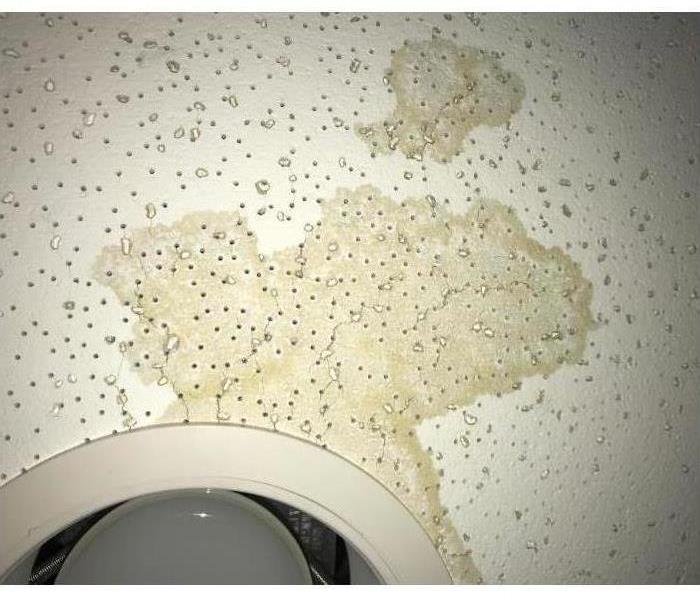 Keep an eye out for tiles looking like this!
Keep an eye out for tiles looking like this!
Imagine it, you've found the perfect home for your business, with just one or two pesky discolored ceiling tiles. It's not a big deal, right? Not quite. Beyond being unsightly, ceiling tile discoloration can have serious causes, from water damage to tile mold. Before you overlook a stain or two, learn some of their top causes in Bismarck.
About Ceiling Tiles
Dropped tile ceilings are a common go-to for many commercial buildings across the country. Reasons include:
- Affordability
- Easy removal for access to HVAC and electrical system
- Clean, simple appearance
Dropped tiles can create a pleasant, conservative look, but can quickly take on a downright ugly appearance when they become stained. Here are some of the reasons why that happens.
Age
Dropped tile ceilings have been popular for decades in buildings. And in some, have been in place for that long. The older the tiles the more likely they've been exposed to cigarette smoke and pollutants. The result can be a darker color that may be impossible to get rid of.
Water Damage
Brown spots are often the biggest giveaway to a leak somewhere above the tile. They often start small and radiate outward over time. Beyond being an eyesore, these spots often signal bigger problems like tile mold, like tile mold, and should never be ignored.
Lighting
The ultraviolent light common in offices is not great for ceiling tiles. Over time, tiles exposed to UV rays can take on a sickly hue that isn't very attractive.
From water leaks and tile mold to harsh light, there are lots of things that can trigger tile discoloration. When you see tile discoloration, it's worth the time and money to replace the tile. Because tile mold can spread, if you suspect water damage is the culprit, make sure you consult a mold remediation company like SERVPRO of Bismarck. It could save you money and headaches in the long run!
What Is Air Duct Cleaning and Why Should We Have It Done?
8/24/2022 (Permalink)
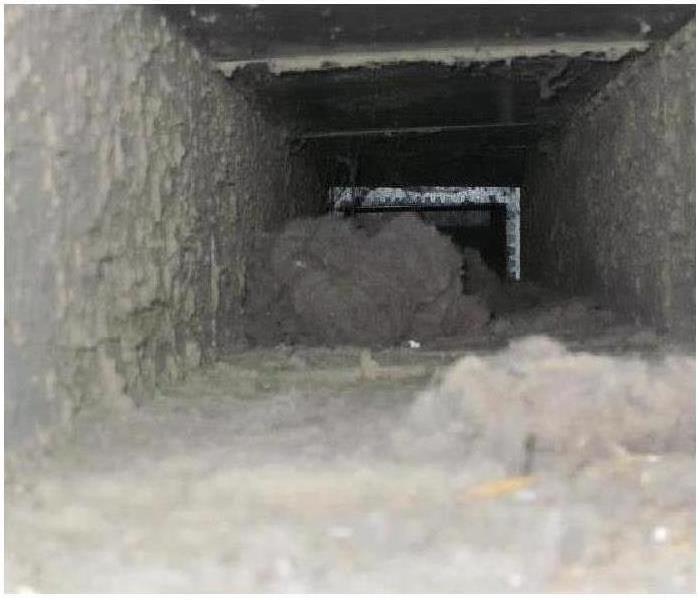 What is lurking in your air duct?
What is lurking in your air duct?
Duct cleaning generally refers to the cleaning of various heating and cooling system components of forced air systems, including the supply and return air ducts and registers, grills and diffusers, heat exchangers, heating and cooling tiles, condensate drain pans (drip pans), fan motor and fan housing, and the air handling unit housing.
If not properly installed, maintained and operated, these components may become contaminated with particles of dust, pollen, or other debris. If moisture is present, the potential for microbiological growth (e.g., mold) is increased and spores from such growth may be released into the air of your commercial business. Some of these contaminates may cause allergic reactions or other symptoms in people if they are exposed to them.
Ventilation systems are often the biggest culprit in poor indoor air quality. Make it a priority to inspect the ductwork of your business.
If your HVAC has been operating for some time without attention, it could be circulating one or more of the following:
- Dust
- Pollen
- Odors
- Dirt and debris
- Other contaminants
The benefits of servicing your HVAC unit include:
- Helps to restore peak energy efficiency
- May help to eliminate offensive odors
- Helps reduce the potential for mold growth
For more information on air duct cleaning, call SERVPRO of Bismarck at 701-415-0525.
Why We Use PPE
8/24/2022 (Permalink)
At SERVPRO of Bismarck we take pride in being able to test for, mitigate, and clean up properties that have been infested with hazardous materials, such as mold.
This is why we make sure to train our staff in all safety measures to handle the problem. One of the most important measures to take is the use of Personal Protective Equipment (PPE).
The use of PPE is important for a few reasons. Most notably, the safety of our staff and the safety and sanitation of the property. Making sure that our staff is trained in proper use and knowledge of PPE is a main priority. This allows them to be safe and focus on the job at the end, rather than worry about exposure to possibly toxic materials. When our staff knows they are safe, they can focus on providing a superior service to our customers.
We take pride in upholding the highest quality standards of safety and this is just one of the ways in which we do it.
Two Tips for Maintaining Your Commercial Property
8/24/2022 (Permalink)
 Tips for Managing Commercial Property
Tips for Managing Commercial Property
In today's world, oftentimes the people who are managing commercial properties are not the owners. Think of a retail setting. There is probably a manager who is in charge of overseeing the operations, including the management of the property. This manager is most likely concerned with the variety of other tasks, like promoting sales or managing staff. This means you shouldn't assume that they are handling the property management as well.
Two things you can do to make sure your properties are taken care of are:
- Make sure you have the best available technology
- Have staff trained in correct management
Technology could include:
- Upgraded security systems
- Energy efficient lights and heating systems
- Upgraded windows and doors for efficiency and security
Another step would be to develop a plan and inform staff of it. This could range from a simple daily checklist, to a full emergency response plan in the event of a disaster.
Emergency response plans are great for directing staff for what to do if there is an emergency. Things to include in this plan are:
- Contact numbers for contractors to come in and stop any further damage.
- Meet up locations in case the building needs to be evacuated
- Business continuity plans for what will happen if the building cannot be occupied for a period of time
At SERVPRO of Bismarck we assist companies with putting together these plans and take pride in out attention to detail and planning these for you.
By taking these steps, you can ensure that your business is managed safely and properly.
What Do I Do if There is a Fire?
8/24/2022 (Permalink)
As the local leader in restoration for fire damage, SERVPRO of Bismarck wants to keep you informed of ways to prevent fire from having a devastating impact on your life.
Here are some tips from The Red Cross:
- Install smoke alarms on every level of your home, inside bedrooms and outside sleeping areas.
- Test smoke alarms every month. If they are not working, change the batteries.
- Talk with all family members about a fire escape plan and practice the plan twice a year.
- If a fire occurs inside your home, GET OUT, STAY OUT, and CALL FOR HELP. Never go back inside for anything or anyone.
"Who should I contact if a fire happens?"
- Immediately dial 911 and have first responders there as soon as possible.
- Make sure anyone who was in the house is out. DO NOT go back into a burning building for people, pets, or belongings. Nothing is as important as your safety.
- Once the fire as been extinguished, contact your insurance provider and see what your policy covers.
- Have them contact us, SERVPRO of Bismarck, and we will work with them for you to make sure everything is restored back to perfect condition.
Meet Our Team: Ryan and Lance
8/24/2022 (Permalink)
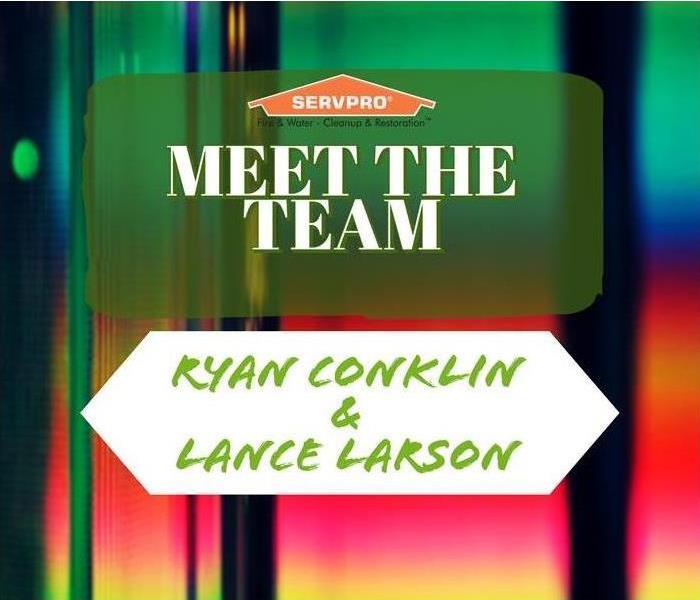 Get to know our owners!
Get to know our owners!
In 2018, Ryan Conklin and Lance Larson were given the opportunity to purchase the SERVPRO of Minot franchise and took over operations in September of 2019. They added SERVPRO of Bismarck in December of 2021.
Ryan was born in Minot and graduated from Garrison High School in 1999. He attained a degree in Applied Science in 2002 from Bismarck State College. He worked for MDU from 2005-2009 where he met Lance and decided to start Absolute Comfort. In 2019, the pair bought the SERVPRO of Minot franchise and Ryan has been operating it since.
Ryan enjoys hunting and fishing, spending time with his wife, Marci, and his two kids Logan and Hailee.
Lance was born in Minot and graduated from Minot High School in 1994. He became a master plumber and started Absolute Comfort with Ryan in 2009. Lance enjoys being outdoors, golfing, and being with his three kids.
As owners of Absolute Comfort in Minot, their business model aligned with SERVPRO services and they saw an opportunity to extend their management philosophy to a new field in their industry. Their commitment of quality, honesty, and bringing peace of mind to those facing emergency home problems has now been combined with the SERVPRO brand.
Being local owners, Ryan and Lance want to contribute to the community. They do that by not only offering 24/7 service, but by giving back through youth sporting activities. This includes sponsoring programs such as:
- Minot Hockey Boosters
- Minot youth basketball
- Bishop Ryan Girls Basketball
- Minot High football, basketball volleyball, soccer, swimming, hockey and wrestling
They believe in improving the quality of life within our community and helping out whenever a homeowner has a crisis.
Tips to Prevent Water Damage
8/24/2022 (Permalink)
One of the great things about living in the modern world is access to usable water. In much of the 3rd world, having water for drinking, cleaning, and plumbing is not possible. With this wonderful access, we have to be careful. If not monitored carefully, the damage can be catastrophic and expensive. Here are some SERVPRO safety tips for preventing water damage.
Most water damage claims do not come from storms, floods, or heavy rainfall, but rather from neglect in monitoring and replacing minor parts. An easy way to prevent damage is to replace and upgrade hosing, pipes, and other small parts that can easily break.
Make sure all of the drains are working properly. If a sink or bathtub isn't draining properly, it could lead to future problems. Ways to keep your drains in good condition are:
- Avoid pouring grease down the drain.
- Keeps drains clean with a regular cleaning schedule.
- Always keep a strainer in place on the sink and shower/tub drains.
- Frequently clean out the strainer and deposit the debris in the trash, not back down the drain or in the toilet.
Prevent ice dams from forming. In the cold North Dakota winter, and ice dam forms when warm air from the attic melts the snow on the roof which freezes in the cold air. If left unchecked, the ice can build up and push into cracks between the walls and roof leading to leaks which can cause water damage throughout your home. Prevention of this includes:
- Having your gutters and downspouts cleaned, inspected, and repaired during the fall to ensure clear passage of water.
- Insulate your attic properly - heat in the home should not reach the attic. Warm air can melt the snow on the roof which refreezes and forms ice dams. Make sure the attic floor is airtight by sealing any openings.
- Providing enough ventilation to the attic to keep the roof cool. Warm air should escape through vents near the top of the attic. Cold air should flow through vents near the eaves. The temperature in the attic should be 5 to 10 degrees warmer than the outside temperature.
- Remove the snow on your roof when it's about 6 inches deep. Use a roof rake or a long-handled brush to remove the snow without a ladder.
The best way to prevent water damage is to maintain and upkeep the quality of your home. These small, and affordable home projects can prevent large, expensive calls down the road.
3 Tips to Prevent Spring Water Damage
8/24/2022 (Permalink)
Even as the snow continues to accumulate, it is important to remember that we will soon be in the spring months. With the warm weather on the way, (hopefully), it is important to remember that with all the snow melting, all the water left in its place can cause problems if you aren't prepared. Here are three quick tips for protecting yourself from any damage that the melting snow could bring:
- Make sure your sump pump is working at 100%. Inspecting it for any built up ice, dirt, or other debris and clearing that out now will prevent failure in the future. Once you have cleared it of any debris, turn it off an on, making sure it starts afterward to ensure it is operating at full capacity.
- A easy way to prevent loss of valuable items is to do some spring cleaning. By going into your basement and cleaning out any unnecessary items that have been stored over the winter and moving valuable ones to safe areas, you can prevent those items from being destroyed in the event of a flooded basement. While cleaning your basement, you can inspect for cracks in the foundation or any other weak spots at risk for letting in water.
- The North Dakota snow is brutal, and while it is hard enough to clear driveways, sideways, and walking paths, it is important to clear as much around your house as possible. Once the snow melts, it can pool underground next to your house and seep in through cracks causing thousands of dollars in damage. By using a snow blower, skid steer, or even just shoveling it away, creating a 3-5 foot perimeter around your house will prevent a large loss of time and money in the future.
As the warm spring weather approaches, it is important to take steps now to make sure you are not at risk of having unnecessary damage to your home.
Preparing for Summer Storms
8/24/2022 (Permalink)
As we get out of winter and inch closer to the summer, it is important to remember another season that is coming up: tornado season. Every year, tornadoes cost about $400 million in damage costs around the United States, with an average cost of $8,179 per house. Just one category F5 tornado, the strongest on the Fujita scale, can cause over $1 billion in damage by itself. To avoid having your entire year ruined by being unprepared for spring storm damage, here are some tips for saving time and money.
- The best way to be prepared for storm damage is to have an insurance policy that covers storm-related damage. Check with your insurance provider to make sure they cover damage from wind, lightning and falling branches. You should make sure you are covered now before the storm comes through. While you take measures to reduce damage, a powerful storm can destroy any safety measures you take. Being covered is your best bet.
- Once you know you are covered for after the storm, there are steps you can take to reduce the possible damage inflicted. One is to reduce the amount of debris around your house that could be blown into your walls and windows. Dead trees and branches should be removed so that they will not be a potential hazard for a violent storm. Also, remove items in your yard such as grills, furniture and children's play equipment, and store them inside when a storm alert has been issued.
- While protecting your property is important, your first thought should be of those living in your home. Making sure you are setup to withstand a storm is a crucial step in keeping you and your family safe. You should have a designated shelter area that is in the basement or at ground level. This area should have no windows and enough space for your entire family to stay in for a few hours until the storm is over. In this area there should be essentials such as: flashlights, a first aid kit, and blankets if the power goes out. You can customize your shelter area to the needs and size of your family.
- Make sure to have a generator prepared as well. A severe storm can knock out power for days and you will be without electricity for your refrigerator, lights, and electric heaters. While power lines are down, generators are one of the first things sold out in stores, so getting one today is a smart, proactive move.
Storms can be frightening, and even worse if you're unprepared. Take these steps to make sure you are ready for summer and any kind of weather it may have.
Where to Place Your Fire Extinguishers
8/24/2022 (Permalink)
Fires are chaotic, unexpected and costly emergencies that impact millions of people each year. In 2018, a US fire department responded to a call every 24 seconds. While we never expect to have a fire, it is an event that impacts 1 in 3,000 households across the country. Hopefully, you will never have to be the victim of a house fire, but you should always be prepared. One of the best things you can do to prepare yourself is to have fire extinguishers available in your house and make sure they are placed in optimal areas to combat any flames.
Before you begin positioning your fire extinguishers, first make sure they are good working order. Make sure the locking pin, located on the handle, is intact and the seal is unbroken. Check the pressure gauge to see if it is still at full capacity and then look for any leaks for damage on the body, handle, or nozzle. Having a certified fire extinguisher inspector look over your units once a year is always recommended. Once you are sure that your fire extinguishers are fully operational you can begin to place them in areas for the best use.
The kitchen is the most common place for home fires to start. With the stove, microwave and other appliances all clustered together, cooking is the cause for 44% of home fires. You should place your fire extinguishers in an unblocked area of the kitchen that is not next to the stove or other appliances. The last thing you want to try to do is reach through flames to get your fire extinguisher. If possible, place it near the center of the room and by a hallway or door so that those entering the room can access it.
Another great place to have an extinguisher is in your shop or garage. This is an area where you likely have stored flammable materials such as gasoline, oils, and painting materials. This, in combination with power tools, can make the garage or shop a mandatory area for having a fire extinguisher. Again, make sure it is stored in a highly visible area that is not blocked or covered.
Now that we are moving into the summer months, you should have a fire extinguisher available at all of your recreation areas. If you are grilling or using a firepit in your backyard, having a fire extinguisher is a must. In addition, having a fire extinguisher in your vehicle for going to the lake, park, or camping trip is a smart move in ensuring everyone can be safe and have fun.
While you can have a fire extinguisher in almost every room in your house, these areas should be prioritized immediately. Making sure you are able to reach a fire extinguisher in under 10 seconds can allow you to contain the damage and save lives. Take a look at your home or business and see where you are vulnerable to a fire and take action to prevent a catastrophe from happening.
Why Your Water Bill is So High
8/24/2022 (Permalink)
How much water does your home use? Every month you might take a look at your water bill and think, "We went through THAT much water?" From the sink, to the dishwasher, toilet, washing machine, drinking water, and gardening hose, you might be shocked at how much water you go through. After a while, your water bill will begin to set into a pattern, and you will know your usual consumption. However, if one month it is an oddly high bill, these could be the causes.
The biggest concern with a high water bill is that there is an unknown leak in your house. Toilets are the first place that should be checked. Toilets are in a continuous state of flushing and can go through almost 200 gallons of water a day! If you hear a toilet running, this is an obvious sign, but by looking into the tank you can often find the source of the problem. Once you have inspected all of the toilets, look at sinks or faucets for leaks to see if they have loose handles, pipes, or cracks that could be dripping water out. Next, check appliances that use water such as refrigerators, freezers, and hot water heaters. The connectors may be loose or have worn down over time and this may be the source of the leak. If you do not find a leak at any of these spots, then maybe there is no leak and it could be one of the other causes for a high water bill.
You may have forgotten about large sources of water use. Water use is not fixed and fluctuates throughout the year. During the summer, you could be using a garden sprinkler or filling up a pool or have more people staying with you, such as kids home for summer break. During the winter, you may have family staying for the holidays or if your heating system is powered through the use of hot water. As the seasons change, so does the use of our water. Make sure to account for this when you look at your bill.
If neither of these seem to be the cause of your high water bill, then it might be time to look at the way you are measuring your consumption. Water meters are used to measure the amount of water you use each year. While there are ways to read this on your property, it is usually done remotely by the water authority. You can request to have your meter checked for accuracy to confirm your previous bill. While uncommon, it is always smart to confirm your bill is accurate.
If you are still not sure the cause of your high water bill, you may have an underground leak. This can be a costly problem to solve and will likely require either bringing in an expert or purchasing detection equipment. There will often be an underground hissing sound that will give away the leak. If you have checked all of the above possibilities for finding the cause of your high water bill. It may be worth considering an underground leak. If you believe this is the case, you should contact a professional inspector to look for the cause and confirm if this is true.
Monitoring your monthly water bill is the best way to make sure you don't have further problems in the future due to water damage. A tiny leak, if left unchecked, can cause thousands of dollars in water damage, sewage, and mold, and you will be left on the hook for the water bill as well. Make sure to monitor your monthly water bill closely and watch for any unknown peaks.
Why You Should Be Concerned About Mold
8/24/2022 (Permalink)
Health Risks
There are over 10,000 kinds of mold. While most of these won't cause adverse health problems, a certain percentage can. It is important to remove mold quickly and safely from your house to avoid health effects that are linked with mold.
Property Risks
In addition to the health risks, mold can cause damage to floors, walls, and ceilings that cost thousands of dollars in repair costs. By attaching to organic materials, mold leaves unsightly stains and smells throughout your home if not removed. For those trying to sell their homes, this can drastically reduce the home value.
Mold damage is caused by humid and moist environments. Typical places include, crawlspaces, bathrooms, and basements, although mold growth can occur anywhere. Monitoring these areas for water leaks, high humidity, and making sure they have ventilation will go a long way in preventing damage from mold. If mold spores make its way into your heating and ventilation systems, they can spread throughout your entire house causing growth to happen all over your home.
Although mold can't grow on inorganic surfaces such as concrete, brick, rock or glass, mold can grow on the dirt of those surfaces. If an uncleaned area accumulates a high amount of dust or dirt which is then exposed to moisture from either a leak or high humidity, there is potential for mold growth.
Things You Can Do
You can prevent mold damage before it occurs. If left untreated, the cost for removal can go from hundreds to thousands of dollars quickly, and beyond your insurance coverage. Make sure to act as soon as you have a suspicion there is mold.
Here are ways to prevent mold growth:
- Control moisture. Keep the humidity level under 60%.
- Dry up wet materials quickly. It only takes mold two days to grow.
- Clean, disinfect, and dry surfaces prone to mold growth.
- Repair leaks. Replace dilapidated old pipes. Fix leaks on the roof, walls and the foundation of the house. Unclog HVAC units, drain regularly.
- Improve airflow at home. Start with opening closet doors more frequently and moving furniture far from walls to provide better ventilation to confined spaces. The more windows you can open, the better.
How to Make Sure Your Family Has a Safe Campfire this Summer
8/24/2022 (Permalink)
With summer approaching fast and being able to go down to the lake, park, or backyard and sit around a warm fire while making s'mores will be a welcome treat. However, making sure it is done safely will prevent a hard year from becoming even worse. Here are some tips to make sure your fire is safe this year.
The three things you need to make sure your fire is safe are:
- The right location
- Proper maintenance
- Fire extinguisher
When choosing the right location for a fire, you should make sure there is nothing in the immediate surrounding area that could catch fire. There should be 10 feet of cleared space around your fire site and nothing overhead such as tree branches or a building overhang, which could be damaged by smoke. Make sure that the location you are using for your fire does not have a burn ban or fire warning in effect so that you are safe from any kind of legal trouble and you know the risk of having a fire. If at a formal campground, look for a fire pit or designated campfire area.
Proper maintenance begins before you ever start your fire. Making sure you have all the materials you need before starting the fire is a key to safety. All fires should have a bucket of water nearby and a shovel or other tools for putting it out. Having a fire extinguisher nearby is near guaranteed way to prevent most fires from ever getting out of control in the first place.
After your fire is started, make sure that someone is always watching over it. Never leave your fire unattended as there are a million different possibilities for something bad to happen. Proper maintenance also means proper behavior with the fire. Do not throw cans, glass bottles or aerosols into the fire as they could shatter and explode sending hot, sharp projectiles all over the area. Likewise, do not allow young children to play too close or throw any objects into the fire.
Maintain the fire by providing the proper amount of fuel. Do not add too much wood or fire igniter as you can easily make a blaze bigger than you can handle. On the other hand, do not let the fire have too little fuel as the more times you have to restart it, the more chances there are that a mistake happens with ignition.
Once it is time to put the fire out, make sure it is really out. A large portion of fire accidents occur after the fire was thought to be put out. Pour the bucket of water you brought with you onto the coals. Then stir the coals around with a shovel or rake and add more water if they are still not cold. Keep stirring until you are able to touch the coals with your bare hand. If the whole family is involved, this whole process should only take a few minutes and be a fun activity to do together while practicing fire safety.
Water Damage Response Tips
8/24/2022 (Permalink)
You are going to panic initially when you realize your home has suffered water damage. Once you give us a call, we can quickly send technicians out to begin remediation on damaged property. Before we arrive, instead of panicking, you can take steps yourself to prevent further water damage. These steps should only be used if the damage is caused by clean water. If you have suffered damage from sewage, toilet, or other contaminated water sources, stay away from the scene as it may have adverse health effects.
Here are tips for what you can do to prevent further water damage to your home until our trained technicians can make it to you:
- Shut off the water source if it can be done safely.
- Remove any excess water by mopping or using towels.
- Remove and prop up upholstery cushions for drying. Do not put cushion covers in washing machine.
- Place aluminum foil or wood blocks under furniture legs.
- Hang furs and leather goods separately at room temperature.
- Remove colored rugs from wet carpeting.
- Do not use a regular vacuum to try and remove excess water.
- If water damage is in the ceiling, do not turn on lights or overhead fans. Keep out of rooms where the ceiling is beginning to sag from holding water.
Preparing Your Property for Colder Weather
8/22/2022 (Permalink)
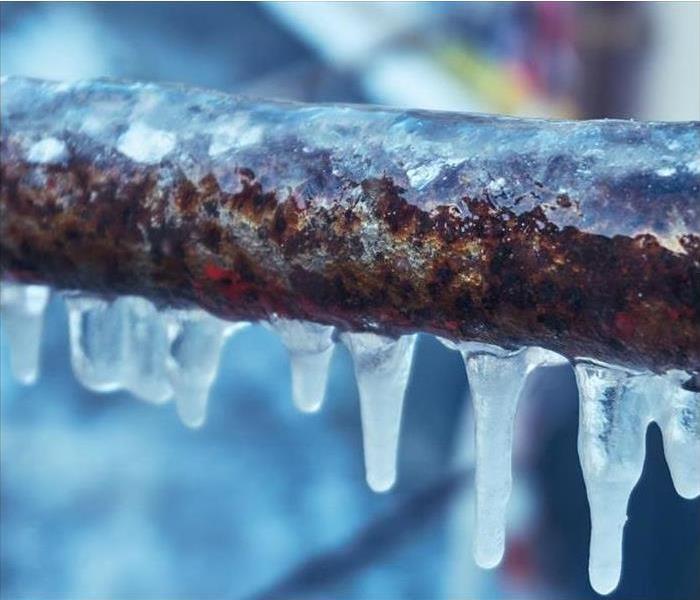 Icicles hanging from a tree branch
Icicles hanging from a tree branch
It's that time of year when the weather transitions from summer to fall. The cooler temperatures, shorter days and changing leaves are all signs that winter is on its way. While some people look forward to the change in seasons, there are others who dread it because they know their property won't be ready for it. You can avoid costly repairs by making sure your home or business is prepared for any inclement weather that comes its way.
Fall also means cooler temperatures and a change in weather that can cause damage to your property if it isn't prepared.
Fall also means cooler temperatures and a change in weather that can cause damage to your property if it isn't prepared. It's important to prepare for the season so that you don't need to make costly repairs when things start going wrong.
Bismarck gets cold fast, and residents know how much of a difference the temperature can make. Trees will be more brittle, which makes them more likely to fall onto power lines or houses during windy days. This can cause power outages or even fires if something catches fire from the heat generated by an electric light bulb. In addition, falling leaves can create debris on lawns that could blow into a storm drain and clog it up, causing flooding when rain comes down hard later on!
It's important to make sure your home or business is ready for the storm season brought on by colder temperatures.
It's important to make sure your home or business is ready for the storm season brought on by colder temperatures. The following steps will help protect your property from weather-related damage and health risks:
Make sure all of your gutters are free of debris and clear where necessary.
Clear leaves and other trash from around any vents or drains on the exterior of your home, and check water pipes regularly while they're still warm to make sure they won't freeze over in colder months.
Move outdoor furniture into an enclosed area if possible; not only will it give you more space inside, but it'll also prevent any potential water damage if rain or snow falls unexpectedly!
Roof maintenance.
Roof maintenance is an important part of preparing your property for the fall weather. The following are some tips to help maintain your roof:
Make sure your roof is in good condition. Check for missing or damaged shingles, loose nails and standing water on the ground around the house. Look for cracks in shingles or missing shingles; this could indicate that a leak has formed.
If you have any concerns about your roof's condition, consult a professional before taking any action yourself as this may make things worse instead of better!
Clear gutters, downspouts and drains of leaves and debris.
The exterior of your home should be in good condition. If you don’t have gutters, it’s time to install them now. Use our handy checklist to make sure that your gutter system is ready for the fall:
Gutter screens - Check for holes or tears in screens. Replace all torn screens with mesh available at most hardware stores
Shingles - Inspect shingles for cracks, missing granules and loose nails
Gutters and downspouts - Clean out leaves, twigs and other debris from downspouts as well as gutters
Drains - Make sure drains are clear so water flows freely away from your home
Trim overhanging branches that can damage roofs and gutters.
When trimming your trees, you should not just focus on the branches that hang over your house. You should also be mindful of any branches that hang close to power lines. If a branch falls onto power lines, this could lead to an electrical fire in your home or garage.
In addition to overhanging roofing and gutters, tree limbs can pose risks for pets as well as people. The best way to avoid these risks is by having all overhanging tree limbs trimmed back before autumn arrives so that they don't drop during inclement weather conditions, causing damage both inside and outside your home!
Inspect outdoor lighting.
Check for loose or damaged bulbs and make sure they are the correct wattage. Also check for exposed wiring and broken or cracked sockets. It's important to look at every bulb on each fixture, as some may work while others don't. You should also check the wires connecting each light to see if they're in good condition—if so, there's no need to replace them (unless you want a new color scheme).
Make sure all of your outdoor lights are working properly by testing each one individually! If there are multiple fixtures within one area, it can be helpful to test them together using an extension cord plugged into an outlet inside your home (don't forget: plugging something into an outlet outside is dangerous). This way you can easily ensure that all of your electrical connections are secure—and if they aren't secure enough already then just tighten them up with pliers or screwdrivers from inside before going back out again!
Check sump pumps and drainage systems.
The sump pump is an important part of your drainage system. It helps keep water away from your foundation and basement by collecting it in a tank, or sump, and then pumping it out into a drain or sewer line. Make sure this is all working properly by checking the following:
Check to make sure water doesn’t pool around the sump pump when it runs. If there’s too much water for the pump to handle, consider adding another one (or two) to increase capacity.
Check that pipes are not clogged with debris such as leaves or branches (and if they are, clean them out).
Check for any cracks in pipes leading to the sump pit--these can lead to leaks that will flood your basement!
Clean up leaves and yard waste.
If you haven’t done so already, it is time to clean up the leaves and yard waste that have been accumulating in your yard. Don’t let leaves pile up in gutters, downspouts or drains. If they do, they may clog the drain and cause water to back up into your home or basement.
Service heating systems to ensure they are working properly before the coldest weather arrives.
Before the first chill of fall arrives, it is important to perform a thorough inspection and maintenance on your heating system. Here are some tips for making sure that your furnace is ready for the season:
Check the thermostat and make any necessary adjustments. Be sure that it's set to a temperature that will keep rooms at 65 degrees or higher during cold weather, but allow them to warm up quickly when it warms up outside (between 55-70 degrees).
Check the filter, which should be changed every 30 days based on how much dust and debris are in your home. Cleaning or replacing filters can help ensure that air circulates properly through vents, improving efficiency while preventing heat loss through ductwork.
Inspect pilot lights as well as blower motors, pressure switches and gas valves for signs of damage or corrosion—these can cause fires if they aren't functioning properly. If you notice anything unusual while inspecting these components, contact an experienced technician immediately so they can be repaired before use this winter season starts heating up again!
People who prepare their properties for cold weather are better protected than those who don't prepare their properties at all
It's a good idea to be prepared for the worst. If you have a home, business or property that may need to withstand cold weather conditions, preparing it for the winter season is key. A few simple steps can help you protect your investment from damage during colder months.
Preparing your home for winter weather
Prepare your insulation by checking all vents and windows to make sure they are closed properly. Be sure not to leave any gaps around doors or windows where cold air can enter through cracks in the walls or floorboards.
Ensure that chimneys are cleared of debris before use—a buildup of debris could cause sparks and other dangerous conditions when using fireplaces during fall/winter seasons! Also keep an eye out for settling dust on ceiling fans; simply wipe them off as needed throughout autumn months so they don't cause issues later on down the line (i.e., getting clogged with dirt!).
Conclusion
Following these tips will help you take care of your property during the fall season. Remember that preparation is key in keeping your home or business safe from the damage caused by cold weather.
Fighting Storm Damage with SERVPRO
8/22/2022 (Permalink)
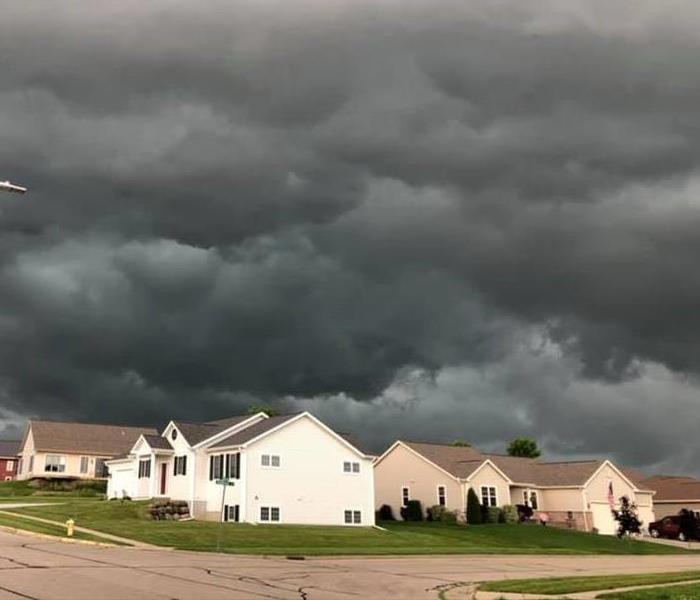 Storm clouds gather above a residential neighborhood.
Storm clouds gather above a residential neighborhood.
A serious storm can wreak havoc in a home.
If you’re facing storm damage in your home, it can feel overwhelming. You may not know where to begin or who to call for help. But with the right tools and knowledge, you can deal with even the worst storm damage on your own.
You don’t have to be a master of disaster response—you just need some basic tools and a few tips from the experts at SERVPRO of Bismarck. We're "here to help"!
The first thing you should do is stop any further water damage by turning off electrical power and gas supplies if possible and removing anything that's been damaged or soaked like rugs and carpets. Once that's done, dry out wet areas using fans or dehumidifiers as needed so mold doesn't start growing on wet debris.
Storm Damage Clean-up and Restoration Services
SERVPRO of Bismarck is a leader in the restoration industry. Our network of franchise professionals are trained to make your home feel like new again. We provide 24/7 emergency services and have over 1,700 franchises nationwide. SERVPRO has been in business for over 30 years, so you can be sure that we are qualified to restore your home or business back to preloss condition. When disaster strikes, you need fast action from a company with experience – that's what you'll get when you call us!
SERVPRO of Bismarck provides a wide range of restoration services, including water damage clean up, fire or smoke damage repair, mold remediation and reconstruction following a storm or other weather event (floods).
Heavy Rainfall
You may not be thinking about it, but water damage can cause mold, wood rot, electrical damage and structural problems. It can also lead to fires and health issues. Water damage can cost you money in many ways—not only the cost of repairing the water damaged areas but also when you deduct from your insurance claim what you spend on temporary housing while your home or business is being repaired.
Storm damage can cause sewer backup and foundation problems.
Storm damage is a serious matter. It can cause flooding, sewer backup and foundation problems. Water can come in through the roof, walls and windows. This can cause damage to the electrical system, plumbing system, HVAC system and drywall.
Ice Storm
During an ice storm, you can expect:
Roof shingles blown off by high winds or heavy weight from accumulations of snow or ice.
Gutters clogged with frozen snow blocking water flow and causing leaks inside the home when melting begins. Snow also collects in gutters after falling off roofs due to high winds, which can lead to leaks inside your house during thawing periods later in springtime months ahead; this is especially dangerous if you live at higher elevations where temperatures fluctuate drastically between nightfall hours (when temperatures cool) versus daytime hours (when temperatures rise again). Due to these fluctuations in temperature levels throughout different seasons throughout any given year cycle (springtime through summer), it's important for homeowners living at higher altitudes like mountain suburbs where trees tend grow tall enough into skyward reaches so as not block sunlight during colder months - because these types of locations typically require more maintenance work throughout seasons due to changing weather patterns! That being said...
Blizzards and Snowfall
When a blizzard or snowfall hits your area, you'll want to be prepared. While most people think of the damage that these events can cause to their homes and cars, they actually also cause some more hidden threats.
Roof Damage: A heavy amount of snow can put a lot of pressure on your roof. This can cause it to buckle or collapse under the weight. If this happens while you're sleeping, it could trap you inside and even cause death if there's no way out!
Water Damage: Snowmelts into water when it melts off in warmer weather. The rainwater pools up in gutters, which overflow onto decks and patios below them (if there aren't drainage systems). This can lead not only to slippery surfaces but also mold growth if left untreated long enough for mold spores from outdoors finding their way indoors via indoor air circulation systems such as furnaces or ventilation fans blowing air from outside into living spaces where people spend most time throughout day/night cycle each day year round (more so during winter months).
After storm damage, you need the professionals at SERVPRO of Bismarck to help you get your life back together.
If you need storm damage cleanup in the middle of the night, we’re here for you. We have expert technicians who can come to your home and begin the process of restoring it to normal. We also have 24/7 emergency service available so that we can respond quickly to any type of storm damage that is happening in your area.
We understand how much time and effort is involved in cleaning up after a disaster like this one, and we look forward to helping you get back on track as soon as possible! Our goal is always to help our clients get their lives back together again by restoring their homes as quickly as possible.
Leaky Pipes
8/22/2022 (Permalink)
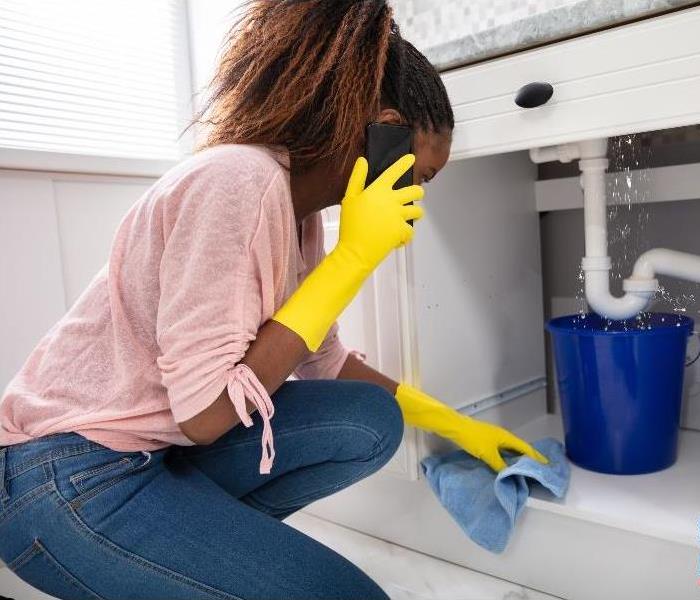 Don't let your pipes look like this!
Don't let your pipes look like this!
A simple drip under the sink doesn't seem like a big issue at the moment. Put a bucket underneath the leaky pipe and the problem is solved, right? Wrong. Think of the simple drip like a very small crack in the Hoover Dam. Say it's patched, but it still leaks. It's patched again and again and the cycle continues, the small fixes, like the bucket, until that crack becomes too big and the dam breaks, causing unimaginable damage to everything the dam was protecting. Still not worried about that little leak under your kitchen sink yet? Hoover Dam vs. your kitchen. The math doesn't add up. But getting the pipe fixed does, and having SERVPRO of Bismarck inspect the area for any water damage or possible mold!
It's important to keep up with the small issues before they become big ones!
Fire Safety with Pets
8/22/2022 (Permalink)
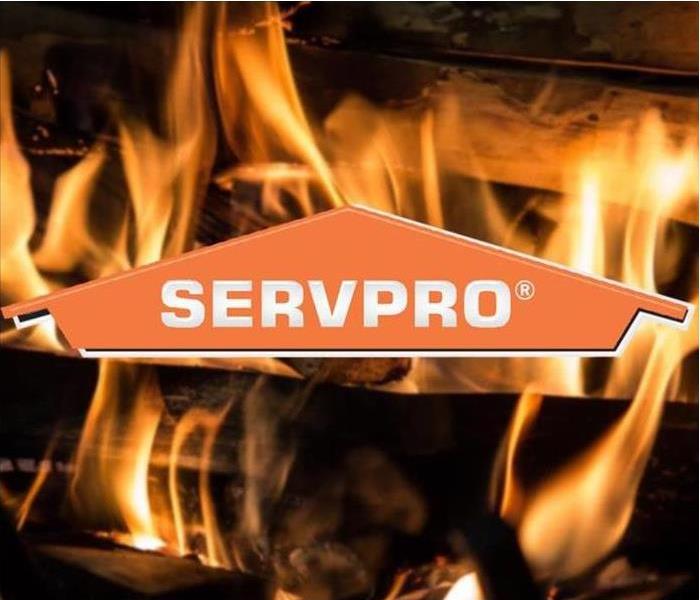 Keep your furry friend safe in the event of a fire!
Keep your furry friend safe in the event of a fire!
Pets are a part of the family, and we want to make sure that they are safe in case of an emergency. We check our smoke alarms regularly and have escape plans for ourselves, but what about our pets? Here are some tips to keep you and your furry friend safe:
Check your home for potential fire risks.
- Are there exposed wires or outlets?
Are there candles lit?
Do you have smoking materials going on?
Do you have flammable materials, like gasoline, in the house?
Do not leave your pet alone with a lit candle or space heater.
It is important to keep pets away from lit candles, space heaters and other fire sources. Pets have been known to chew on electrical cords and candles, causing fires that could be easily prevented.
If you are going out of town or leaving your pet alone in the house for an extended period of time, please make sure that a responsible adult is available to watch over your pet while you are away. There are many good alternatives to leaving them alone such as boarding facilities, friends and family members who will check in on them daily.
It is also important when bringing home new appliances such as lamps or heating units (such as space heaters) that they do not get too close to any combustible materials such as curtains or furniture so there is no possibility for accidental contact with fire sources if something were dropped.
Ensure that all smoke alarms are working properly.
Check batteries regularly.
Replace batteries as needed.
Make sure smoke alarms are installed in all bedrooms, hallways and on every level of the house.
Smoke alarms should be replaced every 10 years.
Test your smoke alarms monthly.
Keep cords and wires out of reach of pets.
Thick cords are more commonly used than thin ones, and they're a particular danger to cats. Cord protectors are available for use on electrical cords that run along the floor, but if you don't have them available at home or work, keep them out of reach by taping the cord up onto walls or taping it behind furniture. You should also consider putting plastic covers over exposed electrical outlets so your pet won't stick their little paws into them and receive an electric shock.
You may want to take extra steps when it comes to cables and wires in your home: it's easy for pets to chew on these things! If there's anything in particular that seems too tempting for your pet(s), try covering it with tape until the problem is resolved -- this will probably be pretty effective at deterring them from chewing on said object!
Practice your pet's fire escape plan as often as possible so they will remember it in case of an emergency situation.
Practice your pet's fire escape plan as often as possible so they will remember it in case of an emergency situation.
Practice in different locations in the house, including outside the house.
Practice under different weather conditions and times of day.
Check your pet's ID tags. If they have disappeared, replace them immediately with new ones that have your current contact information.
Teach older pets (over 7 years) to wear a collar with identification tags at all times, even if they aren't going out of the house or yard.
Make sure everyone in your household knows where the key is located for the door leading outside of the house that leads to any area where a pet may be kept outside at night or under other circumstances when you are unable to monitor them personally during all waking hours (e.g., when you go on vacation).
Conclusion
The most important thing is to be prepared for a fire. Make sure that you have an escape plan with your pets, and practice it regularly so that everyone in the household knows what to do in case of an emergency. You should also take steps to prevent fires from starting—for instance, keeping candles away from pets’ access and keeping wires and cords out of reach can go a long way toward preventing accidents. Finally, don’t forget about smoke alarms: these devices are critical because they alert people when there is danger nearby!
Dealing with Fire Damage at Your Commercial Property
8/22/2022 (Permalink)
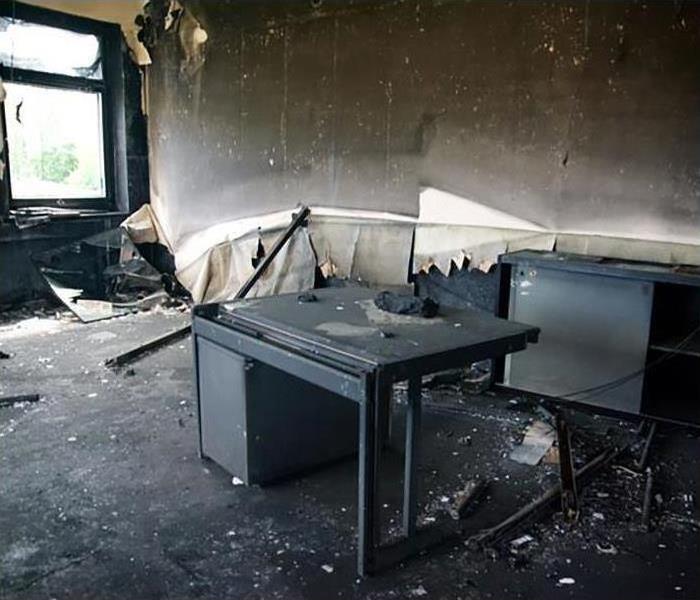 Fire damage to a business
Fire damage to a business
A fire anywhere is never easy to deal with, especially if it's your own business where it can be hard to stop or continue operations to clean up the destruction left behind. That's why SERVPRO of Bismarck is "here to help" you get your business back on track.
Let SERVPRO of Bismarck:
- sanitize and disinfect all of the restorable items and structures that were damaged
- use specialized equipment to remove smoke and soot from ceilings, walls, and other surfaces
- remove odors using industrial air scrubbers and fogging equipment
- restore any minor repairs such as replacing drywall, painting, and installing new carpet
- restore any major repairs such as the reconstruction of various rooms in your business
At SERVPRO of Bismarck, we're dedicated to getting your business back into the swing of things and making you feel "like it never even happened".



 24/7 Emergency Service
24/7 Emergency Service






































